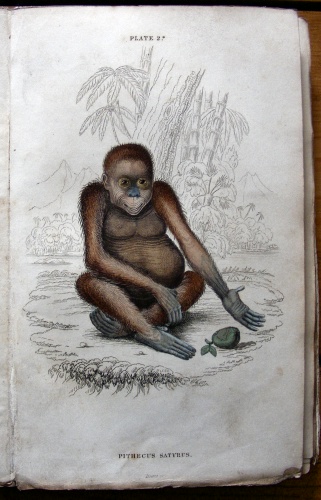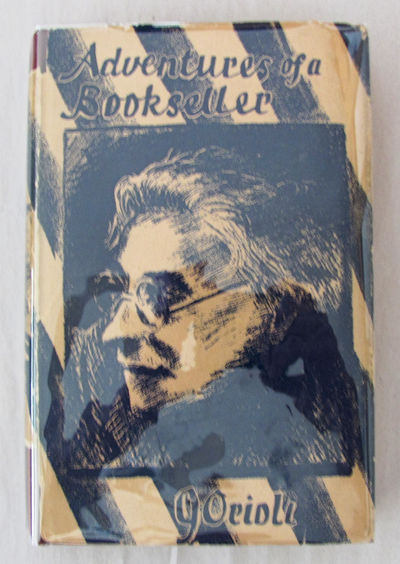
Adventures of a Bookseller
Orioli, G New York, 1938 Hard cover. Octavo. [viii] 329pp. Extensive scholarly pencil marginalia and notes. Dust jacket worn and torn with loss to the spine and a closed tear to the front. Now protected in an archival quality mylar sleeve. Giuseppe "Pino" Orioli (1884–1942) was a Florentine bookseller best known for privately publishing the unexpurgated first edition of Lady Chatterley's Lover and for his long association with Norman Douglas.- $180
- $180
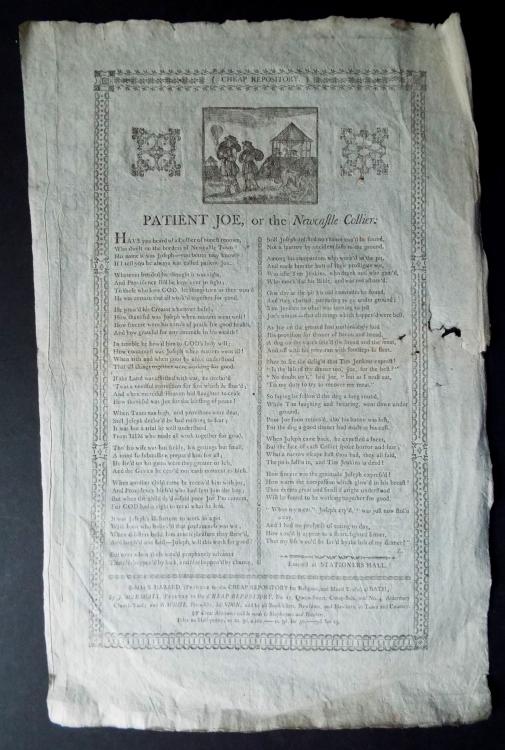
Patient Joe, or the Newcastle Collier.
Broadside: (Hannah More). Broadside (11 x 18ins, 280 x 445mm) printed slightly off-centre on the sheet, paper fault in one margin, just into the printed surface, but very crisp, on laid paper. Decorative engraved border, 18 verses signed "Z", wood-engraved head-piece of Joe, the unfortunate Tim Jenkins, the dog stealing Joe's dinner, with a horse powered pit-head in the background. Reprinted in later bound collections, this is the original format. "The threat of war and revolution impelled her to write dozens of. tales specifically for the lower classes that were published anonymously. and distributed by booksellers and peddlers across the country." ODNB.- $270
- $270
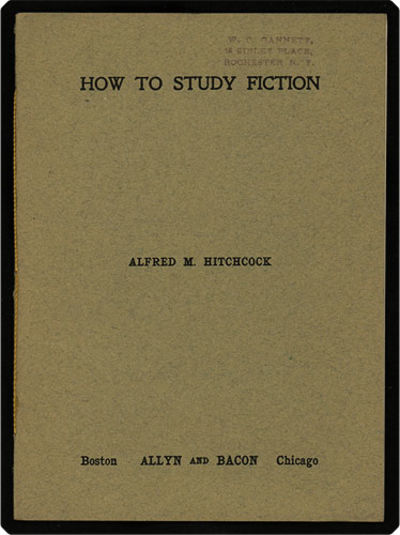
How to study fiction.
Hitchcock, Alfred M[arshall]. Boston & Chicago, copyright 1899 Boston & Chicago: Allyn & Bacon, copyright 1899. 16mo (15.6 cm, 6.14"). [2], 13, [1] pp. Scarce little educational pamphlet offering an overview of how to engage with a novel or story, written by a teacher at Hartford Public High School and aimed at students of that age range as well as at older people who might still find themselves "without a definite plan of study." A search of WorldCat finds => only one reported U.S. institutional holding (Harvard). Provenance: Front wrapper with rubber-stamp of William C. Gannett, clergyman and reformer; the Rev. Gannett and his wife ran a number of reading and study groups associated with the Unitarian Church in Rochester, NY. Sewn in publisher's printed paper wrappers; wrappers gently sunned and with rubber-stamp as above. => Crisp and clean.- $100
- $100
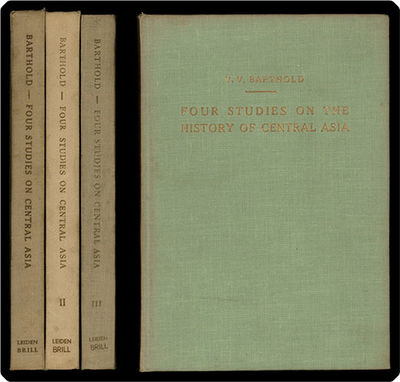
Four studies on the history of Central Asia.
Barthold, Vasily Vladimirovich [Wilhelm]; Vladimir & Tatiana Minorsky, transl. Leiden, 1956, 1958, & 1962 Leiden: E.J. Brill, 1956, 1958, & 1962. 12mo (19.6 cm, 7.71"). 3 vols. I: Frontis., xvi, 183, [1] pp. II: Frontis., xii, 200 pp.; 2 plts. III: vii, [1], 187, [1] pp.; 1 plt. First edition in English, translated from the original Russian and in three volumes as issued, with the first volume containing "A Short History of Turkestan" and "History of the Semirechyé," and the second and third volumes subtitled Ulugh-Beg and Mi?r ?Ali?-Shi?r: A History of the Turkman People. There are a total of five plates, including the two frontispieces. Publisher's light green cloth, front covers and spines with gilt-stamped titles; spines and board edges sunned. Pages clean.- $150
- $150
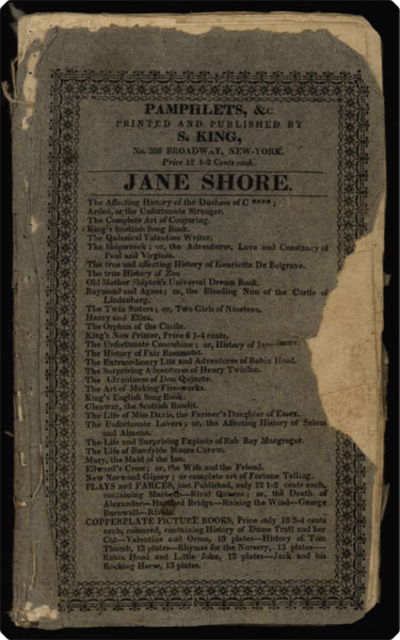
The unfortunate concubine; or, history of Jane Shore, mistress to Edward IV. King of England.
(Jane Shore). Prudhomme, John Francis Eugene, illus. New York, 1822 New York: S. King, 1822. 12mo (19.5 cm, 7.67"). Col. frontis., [2], [9]–34 pp. Showing how she came to be concubine to the king; with an account of her untimely end": An uncommon early 19th–century American printing of the ever-popular story of Jane Shore. This version opens with => a delicately hand–colored frontispiece showing an attractive (if anachronistic) lady in Regency dress, signed "E. Prud'homme," i.e., the esteemed artist and banknote engraver John Francis Eugene Prud'Homme. The front wrapper advertises a list of other S. King pamphlets. Shoemaker 10502. Publisher's printed paper wrappers, roughly sewn, with previous sewing holes showing; sections of chipping to edges, affecting the fore-edge of the front wrapper rather deeply taking border but not text. Pages age-toned with edges untrimmed, moderate foxing and variable staining; frontispiece with old repair to outer edge, small area of insect damage in upper inner margin. => A scarce production, with a nice example of Prudhomme's early work.- $300
- $300
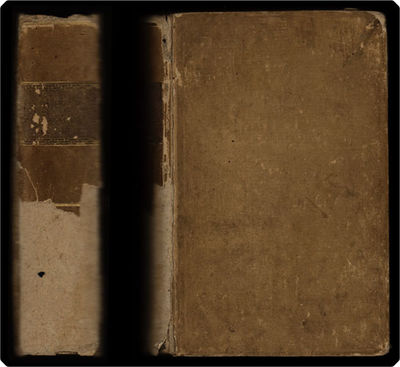
Gedichte von Friedrich Wilhelm August Schmidt. Mit Kupfern und Music.
Schmidt, Friedrich Wilhelm August. Berlin, 1797 Berlin: Haude und Spener, 1797. 12mo (13.5 cm, 5.31"). Engr. t.-p., iv, 306 pp. (pp. 303–06 bound between 286 & 287); 15 plts. (5 col.). Elegant little printing of these pieces from a poet known for focusing on the simple joys of rural life — and for being mocked for that by Goethe, who did acknowledge, however, that Schmidt showed genuine poetic merit. The minute but legible text is graced with => a copper-engraved title-page, 15 attractive copper-engraved plates, and two folding leaves of sheet music for settings of "An den Mond" and "Liebe," composed by Johann Friedrich Reichardt. In this copy, => five of the engravings are skillfully and subtly hand-colored, four of those having been excised and mounted (sans captions) back in the appropriate places. This is the second edition, following the first printed by Spener in 1795; the text has been => completely reset, appearing here in roman type rather than the fraktur of the first edition. Provenance: From the library of American collector Albert A. Howard, small booklabel ("AHA") at rear. VD18 11236914 (for 1795 ed.). Contemporary tan paper–covered boards, spine with gilt-stamped title-label; cocked, rubbed overall, spine paper largely lost and label rubbed with lettering all but lost. Pastedowns with small adhered spots of blue paper, and title-page partially separated; most guard leaves present, some crumpled; mild to moderate foxing to pages. Worn condition notable; still => a production and a copy both appealing and worthwhile.- $550
- $550
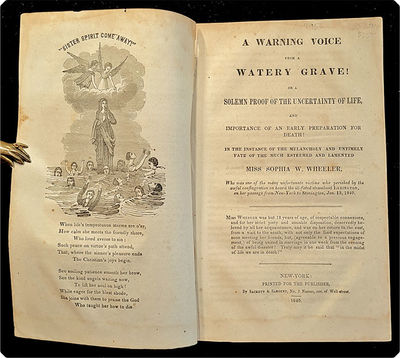
A warning voice from a watery grave! Or a solemn proof of the uncertainty of life, and importance of an early preparation for death! In the instance of the melancholy and untimely fate of the much esteemed and lamented Miss Sophia W. Wheeler.
[Weild, C.]. New York, 1840 New York: Pr. for the publisher by Sackett & Sargent, 1840. 8vo (21.7 cm, 8.54"). 24 pp.; illus. Just 18 years old and about to be married, Wheeler was "one of the many unfortunate victims who perished by the awful conflagration on board the ill-fated steamboat LEXINGTON, on her passage from New-York to Stonington, Jan. 13, 1840" (per the title-page). Here, the untimely end of the Massachusetts native — and almost everyone else aboard the luxury vessel — provides a cautionary tale to Christians in need of preparing themselves for eternity. => This sole edition of "A Warning Voice" opens with the poem "Sister Spirit Come Away," illustrated with a wood-engraved scene of angels watching over the victims as they drown; a poem written by Eliza Perkins. Portions of several other poems about the catastrophe are included, one written specifically for Sophia, and one that begins "Death follows in the wake of Time and sweeps / Away the aged and the blooming young." Also present are lists of officers, crew, and passengers of the Lexington, and an account of the various ways in which they perished. The authorial attribution comes from the copyright information. This item is => scarce, with very few institutions reporting hard-copy holdings. Sabin 101453; American Imprints 40-6819. Removed from a nonce volume; sewing going, with some leaves all but separated. Upper and lower edges waterstained, into margins but not text; pages age-toned overall with occasional foxing.- $250
- $250
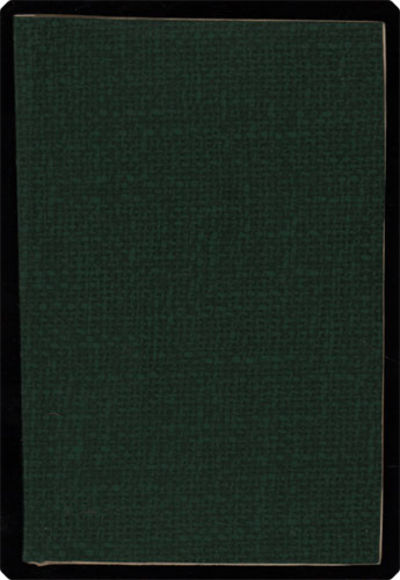
The autobiography of William Love, P.C. a native of Paisley, better known as the Roving Scotchman, the greatest traveller alive!
Love, William [pseud.]. Paisley, 1857 Paisley: G. Caldwell, 1857. 16mo (15.5 cm, 6.1"). Frontis. (incl. in pagination), pp.; illus. Satirically dedicated to the Paisley Literati, this is the comic life story of a traveling peddler, "containing an account of his birth, parentage, and education, travels to remarkable places, love adventures, opinions on things in general, with philosophical remarks on particular subjects" — and breaking into => occasional font exuberance to emphasize highlights. The text is illustrated with a whimsical engraved frontispiece portrait captioned "Magnus est amicus et praevalebit" and two in-text vignettes. A search of WorldCat finds => only three reported hard copies of this sole edition in U.S. institutions. Provenance: Inside front wrapper with printed ex libris label of J.L. Weir. Later paper wrappers; frontispiece with outer edge just slightly shaved, title-page with small inked numeral by imprint, last page evenly browned. => A nice copy of an uncommon item.- $100
- $100
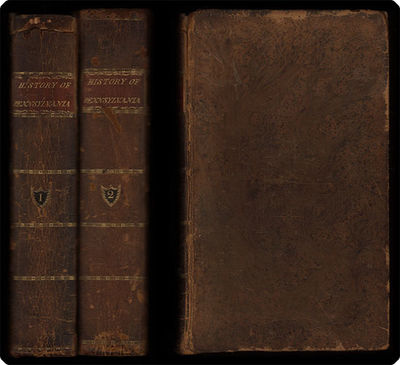
The history of Pennsylvania, in North America, from the original institution and settlement of that province, under the first proprietor and governor William Penn in 1681, till after the year 1742.
Proud, Robert. Philadelphia, 1797-98 Philadelphia: Zachariah Poulson, Jr., 1797-98. 8vo (21.5 cm, 8.5"). 2 vols. I: 508 pp., [1] leaf of plates (portrait). II: 373, [1], 146 p., [1] folded map. An important and standard late 18th-century history of Pennsylvania by a native of Yorkshire, England, who settled in Philadelphia in 1759 and remained there (here!) until his death in 1813. In addition to its standard fare (i.e., "The history of Pennsylvania, 1676–1709"; "The history of Pennsylvania, 1709–1763"; "A view of the province of Pennsylvania ... between the years 1760 and 1770"), the work's appendix includes "Certain Conditions, or concessions, agreed upon by William Penn," "The Frame of the Government of the Province of Pensilvania, 1682, 1683, 1696," "The Charter of the City of Philadelphia, 1701," and the "Journals of Christian Frederick Post, from Philadelphia to the Ohio, 1758–59." John James Barralet (approx. 1747–1815) supervised Alexander Lawson (1773–1846), the engraver of the William Penn portrait that serves as the frontispiece to vol. I, and James Thackara (1767–1848) was the engraver of the map in vol. II. Binding: Contemporary tree calf, spines divided into compartments by attractive and thoughtful gilt tooling; red leather title-labels with additional delicate gilt bordering. Volume numbers gilt to small black leather shields defined by additional modest gilt. Provenance: Hannah Ann Morris Buckley on fly-leaf of vol. I; signature of Sarah Wistar in top blank area of each title-page. The Morris and Wistar families were important Philadelphia families and much intermarried. Sowerby, Catalogue of the Library of Thomas Jefferson, 460; Evans 32729, 34421; ESTC W020454; Howes P 639; Sabin 66223. Bound as above, volumes scuffed with joints outside starting to open from tops yet solid. Foxing and age-toning as would be expected, only; map in good condition. => Overall, a very nice set.- $600
- $600
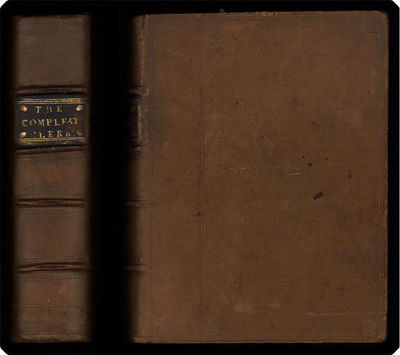
Compleat clerk containing the best forms of all sorts of presidents, for conveyances and assurances.
H., J. [i.e., John Herne?]. London, 1677 London: Pr. by G. Sawbridge, T. Roycroft, & W. Rawlins for H. Twyford et al., 1677. 8vo (23.5 cm, 9.25"). [4], 936, [80] pp. Important legal reference work here in its fourth, expanded, 1677 edition, following the first of 1655. The text is printed in roman, italic, and blackletter with typographic headpieces; one page bears an illustration of the notary's mark on an "antient" resignation (p. 599). The present copy lacks the additional engraved title-page dubbing the work "The Conveyancers Light," but does include the appendix of titles, cities, weights, and personal name variants in Latin, the glossary of obsolete words, and the table of kings' reigns, as well as => "The several Parts of the Bodies of Men, Women, Children, Beasts, Birds, Trees, Plants, Hearbs . . . both in Latine and English. The like whereof hath never been done before, and will be much for the ease and benefit of the Attorney and Clerk." Provenance: Front pastedown with armorial bookplate of Richard Hopton of Canon Frome, Hereford; and with ownership inscription of I.A. Shapiro, noted scholar of 17th-century literature. Wing (rev. ed.) C5636A; ESTC R25473; Sweet & Maxwell, I, 480:16. Contemporary calf, framed and panelled in double blind fillets with blind-tooled corner fleurons, spine with blind-ruled raised bands and gilt-stamped leather title-label, board edges with gilt roll; small scuffs and some rubbing to binding with a few pinhole spots of insect damage to spine. Front pastedown with bookplate and inscription as above, additional engraved title-page lacking, title-page with small early inked annotation in lower portion; text age-toned with offsetting and foxing ranging from faint to moderate. One leaf with short tear from outer margin, not touching text; one leaf with small repair in upper outer margin. => A sturdy, usable copy in a dignified contemporary binding.- $1,500
- $1,500
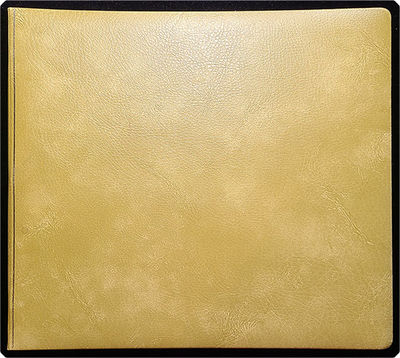
Typed Letters Signed.
Bailey, Albert William. Rhodesia & Angola, 1912–1921 Rhodesia & Angola, 1912–1921. Folio (34.29 cm, 13.5"). [32] pp.; 1 photo.. Large-format album of 16 missives from the Rev. Albert William Bailey (1873–1955), Baptist missionary to Africa and leader of the first attempt to establish a Christian mission among => the Nkoya. The collection opens with a black and white photographic portrait of Bailey, followed by 14 letters variously addressed to his brother, son, and friends, and two typed manuscripts entitled "A Promise Redeemed" (ca. 1914) and "A Shaking Among the Bones" (ca. 1918). Along with accounts of his preaching, his school and the students there, his work on => translating the Gospel of John into the Mbunda language, and his day-to-day experiences (including cobra encounters!), the letters include thoughts on mission and church finances, American politics (particularly the presidential election), and crime in New York — as well as an assurance to his son that yes, he had seen crocodiles, although not yet shot one. Most of the letters are typed, with handwritten signatures, postscripts, and occasional corrections, while one is entirely handwritten. Two notable running themes are Bailey's unshakable conviction in the importance of his work in Africa, and the complexity of his long-distance relationship with his son (left behind in America with his aunt and uncle), whom he alternately praises and criticizes; one letter acknowledges with sadness and resignation that the beloved but wayward Paul has left the Baptist church in favor of "the Universalists." Overall, this is => a remarkable look at the work of an influential missionary then at his peak. 20th-century mustard-colored leather–covered album; minimal shelfwear. Page sleeves and backings age-toned; one sleeve starting to split from foot of inner margin. Letters age-toned with occasional edge chips. => Unique and fascinating.- $900
- $900
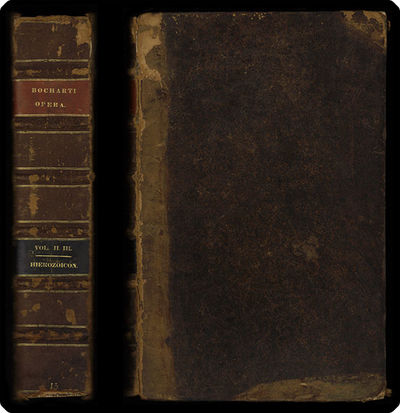
Hierozoicon, sive bipartitum opus de animalibus s. scripturae.
Bochart, Samuel. Lugduni Batavorum, 1712 Lugduni Batavorum: Apud Cornelium Boutesteyn & Samuelem Luchtmans, 1712. Folio (39.5 cm, 15.5"). [8], 63, [1] pp., 1094 cols., 91 (index), [3] pp., 888 cols., 79 (index), [1] pp.; illus. (lacking 1 prelim. f. & 1 plt.). Early, handsome edition of this treatise on the animals of the Bible, written by an eminent French Protestant biblical scholar, natural historian, and student of Oriental languages. The Hierozoicon was first published in 1663 and widely acclaimed at the time for its erudition and its => comprehensive presentation of classical material relating to every creature mentioned in Scriptures; it appears here in its stated fourth edition, originally issued as vols. II and III of Bochart's Opera omnia with spine labels reflecting that. This large volume's title-page is printed in red and black and features an attractive engraved vignette, as does the separate title-page of the second portion, while the text is printed in => Latin, Hebrew, Greek, and Arabic. Brunet, I, 1022 (for Opera). Contemporary mottled calf, rebacked in the 19th century with sheep, spine with gilt-stamped red and black leather labels; worn overall, sides scuffed, leather chipped and cracking, joints tender and starting from extremities. Front pastedown with small institutional bookplate, preliminary leaves with pencilled and (small) inked numerals, title-page institutionally rubber-stamped (quite neatly, and volume properly deaccessioned). Light to moderate foxing largely confined to margins, light soiling as of old use; in fact a clean, attractive volume. As noted, not present here is the other volume of Bochart's Opera; also lacking are the one-page "Praefatio praemissa editioni anni CICICCXCII" (not found in all copies) and the engraved portrait of the author. => This Hierozoicon is textually complete in and of itself.- $800
- $800
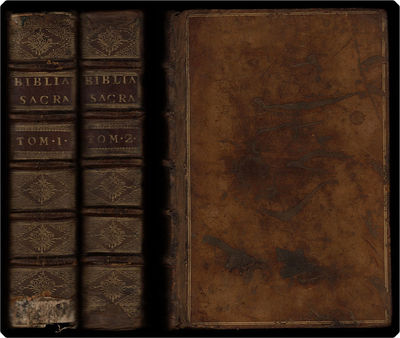
Sacra Biblia vulgata editione, translat. ex Hebraeo sanctis Pagnini, transl. Romana ex Septuag. & Chaldaicae paraphrasis transl. congesta fratris Fortunati Fanensis Ordinis erem. S. Augustini studio et labore.
Bible. Latin. Vulgate. 1609. Venetiis, 1609 Venetiis: Apud Antonium Pinellum, 1609. Folio (29.6 cm, 11.65"). 3 vols. in 2. I: [24], 1102, [2] pp. II: [8], 674 (i.e., 678, some pagination repeated), [10], 326, [34 (index)] pp. Fortunato Scacchi's edition, from the press of eminent Venetian printer Antonio Pinelli. These volumes present the Vulgate Latin version of the Pentateuch alongside Latin translations from the Hebrew (done by Pagninus), from the Septuagint (by Flaminio Nobili et al.), and the "Chaldee" paraphrase (as in the Antwerp Polyglot), laid out in four parallel columns across two pages. Joshua through Ezra appear in parallel columns with the Septuagint across the foot of each page, per the Vulgate and Pagninus, with subsequent books being variously given in that layout or with the Vulgate and Septuagint side by side; and the New Testament is given in the Vulgate and in the translation from the Syriac by Guido Fabritius Boderianus (Guy Le Fe?vre de La Boderie). Each volume opens with an engraved title-page in an architectural border, highlighting the arms of Cardinal Scipione Borghese. The text columns are set in alternating roman and italic type, with ornamental capitals and attractive woodcut tailpieces; the title-pages (including the separate New Testament title) are printed in red and black, and the colophons feature the Pinelli tree device in an elaborate frame. Binding: Mid-18th centry mottled sheep, covers framed in gilt double fillets and board edges gilt also; spines with gilt-stamped leather title and volume labels, raised bands, and gilt-extra compartments in filigreed, beaded patterns. The unusual, striking endpapers are of mauve paper gilt-stamped in an ornate pattern of acanthus leaves, pomegranates, and assorted flowers. Thanks to Sandrine Hermine Salières-Gagloff for identifying the paper as from the atelier of Iohann Wilhelm Meyer. II, of Ausgburg and dating from ca. 1755. All page edges marbled. See Darlow & Moule 6201. Bound as above with sides scuffed, joints and edges rubbed; vol. I spine head pulling away and foot leather chipped partially revealing binding structure, vol. II with joints and spine extremities nicely refurbished. Vol. II with hinges (inside) and one leaf's margin neatly reinforced some time ago, and endpapers unevenly faded; vol. I and II title-pages and vol. I colophon mounted. Instances variously of small marginal worming or spotting; of short tears, closed or affecting a border or a few letters only; and of light waterstaining with a few leaves actually browned. One page with substantive annotation in Latin. => An edition not widely held institutionally, here in an impressive set.- $1,850
- $1,850
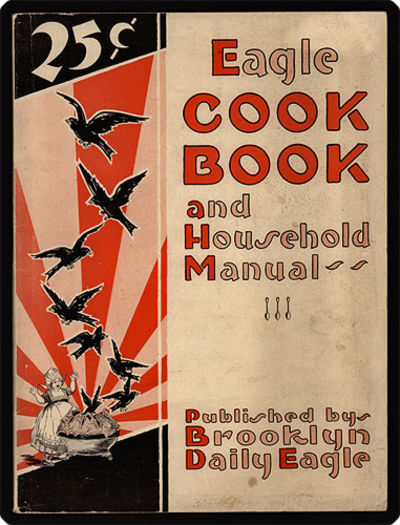
The Eagle cook book and household manual.
Hufcut, Rebekah S. New York, copyright 1928 New York: Brooklyn Daily Eagle, copyright 1928. 8vo (26.1 cm, 10.27"). 112 pp.; illus. Sponsored and published by the Brooklyn Daily Eagle, this magazine-format cookbook (vol. XLIII, no. 2 of the Eagle Library, serial no. 274) offers "general recipes" along with suggested menus for seasonal breakfasts, luncheons, and dinners, as well as special occasions, school lunches, and midnight suppers. The recipes are interspersed with advertisements for Cox's Gelatine, the Great Atlantic & Pacific Tea Co. (better known as A&P), Hecker's Flour, Scranton & Lehigh Coal Co., the Sylvan Electric Bath, and a large number of Brooklyn-area banks; one ad for a driving school offers "Special Ladies' Classes" to "learn to drive through traffic" (p. 106), while the Prudence Company pitches its Women's Investment Service and the Lamb's Business Training School proclaims "every graduate placed" after training in shorthand, touch typing, filing, bookkeeping, and secretarial practice — these advertisements providing => an interesting contrast to editor Hufcut's stated principle that "Woman's place is in the home." Hufcut was director of the Home Economics Department of the Young Women's Christian Association of Brooklyn; her biography page here notes that she "comes from that sturdy mid-Pennsylvania stock that for generations knew and appreciated the best in life" (p. 5). Publisher's color-printed paper wrappers, front one with Dutch child and blackbird-containing pie illustration; wrappers showing light wear overall, slight dust-soiling. Small area of bump/tear-damage to lower outer margins of perhaps a dozen leaves, one with part of a closed tear running into print area, without loss of text; otherwise, expectable age-toning only. => A scarce survivor, in very usable, browseable condition.- $150
- $150
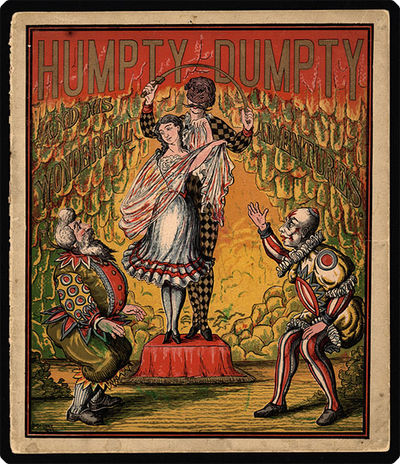
Humpty Dumpty and his wonderful adventures.
Geyser, J.B., illus. [Cincinnati, 1881?] [Cincinnati: Peter G. Thomson, 1881?]. Large 4to (27.1 cm, 10.66"). 8 ff.; col. illus. This Humpty is a clown rather than an egg, due to falling afoul of a passing fairy. His roguish escapades — which culminate in being eaten by a whale! — are told in verse and illustrated with => a vividly colored cover and six full-page illustrations chromoxylographed from designs by J.B. Geyser, the cover additionally enhanced with gilt-stamping. Unlike at least one digitized copy, the present example of this toybook does not bear Thomson's information at the foot of either the front or the back wrapper (the back wrapper here substitutes "For sale by all booksellers"), but the text and illustrations otherwise match that printing. Hard copies of this 19th-century printing are scarce: a search of WorldCat finds only six U.S. institutions reporting holdings (Monmouth County Historical Association, New York Public, New York State Library, UCLA, University of Florida, Yale). Publisher's tan paper wrappers, front wrapper pictorially stamped in color and gilt, back wrapper with publisher's advertisement; wrappers slightly darkened with smudges to outer margins and spots of discoloration to back wrapper, spine starting to split. Scattered small spots to pages. => Slightly fragile overall, but an impressively bright, engaging, and desirable item.- $450
- $450
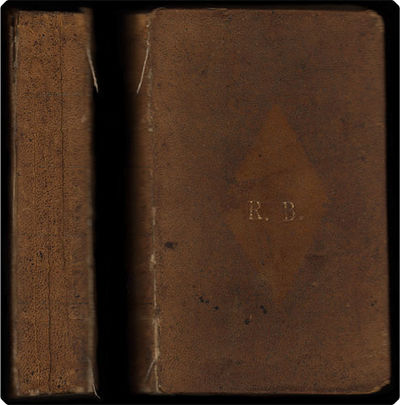
A new version of the Psalms of David. Fitted to the tunes used in churches.
Bible. O.T. Psalms. English. 1790. Tate & Brady. Boston, MA, 1790 Boston, MA: Pr. by Joseph Bumstead for David West & E. Larkin, Jun., 1790. 12mo (15.1 cm; 5.94"). 358, [2 (adv.)] pp. The Tate and Brady metrical translation of the Psalms succeeded, in 1696, the Sternhold and Hopkins version as that preferred for use in many of the parishes of the Church of England. It was sometimes published with the music, though not in the present Boston printing; included here are "Hymns, collected chiefly from Dr. Watts's hymns" (pp. 277–358), and a final leaf of bookseller's advertising. This copy of the popular hymnal was => owned by (at least) two musical clergymen (see below). Provenance: Front cover gilt-stamped "R. B[oyd]." Front pastedown with ex libris of the Rev. Frederick Lucian Hosmer (1840–1929), an American Unitarian hymn-writer and professor of hymnody, partially overlapping older armorial bookplate of the Boyd family; front free endpaper with bookplate of the Rev. Stanley Armstrong Hunter (1888–1959), author of Music and Religion and The Music of the Gospel, and pastor of first the North Presbyterian Church of Pittsburgh, PA and then St. John's Presbyterian Church of Oakland, CA. Evans 22351; ESTC W5075. Contemporary sprinkled sheep, covers each with diamond-shaped smooth and unsprinkled panel, front panel stamped "R.B." as above. Binding slightly cocked, acid-pitted and worn overall; spine leather showing cracks with both joints cracked and barely holding, back one reinforced inside some time ago; offsetting from turn-ins to early and late leaves. Bookplates as above, Boyd's with rubber-stamp of a religious institution (properly deaccessioned) overlapping its lower edge and Hosmer's with later inscription in pen of Stanley Astunler [?]. One leaf with closed tear into text without loss, another with lower outer corner torn away also without loss; general age-toning with one signature more noticeably browned and variable vut never more than "moderate" foxing throughout. => An obviously well-loved copy with pleasing provenance.- $450
- $450
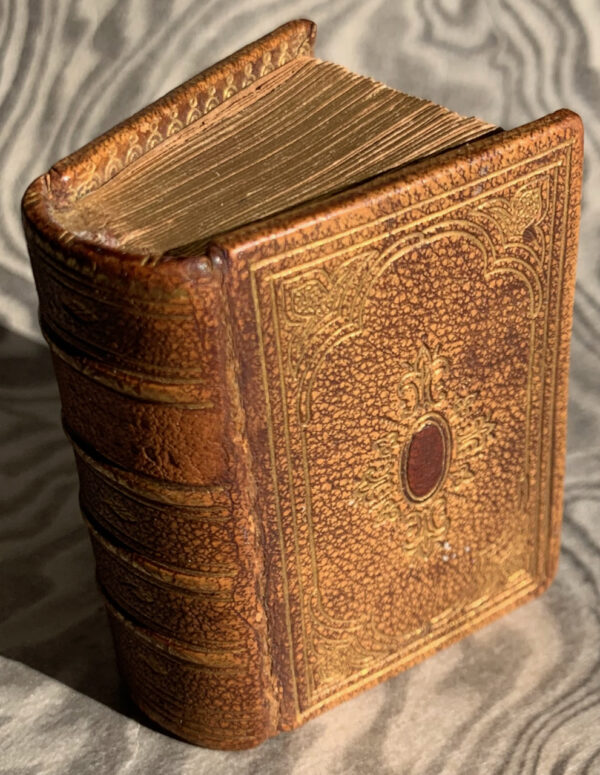
Galleria Dantesca Microscopica
Miniature Book. 2 1/8 x 1 5/8 inches. Unpaginated. [84] pp. Half-title, title page printed in red and black inks, 30 original photographic images mounted on plates with tissue guards, decorative initials, tailpieces, index; text unmarked, title page repaired with cellophane tape with corresponding toning, pages toned, some leaves with small marginal chips, text and tissue guard torn at images 15 and 16, ms. notation on half-title. Full tan morocco, elaborately gilt, raised bands, tan leather spine label titled in blind, red leather on-lays within a medallion in the center panel of both the front and rear cover, all edges gilt, gilt green patterned end-papers, turn-ins gilt; binding square and tight, spine and rear cover with some toning. SA1019-030. SCARCE. Very Good. THE FIRST MINIATURE BOOK TO CONTAIN PHOTOGRAPHIC IMAGES. This work was issued as a companion volume to Ulrico Hoepli's La Divina Commedia (Milan, 1878, known affectionately as the Dantino). "It contains thirty original photographs in black-and-white of the paintings by Scaramuzza [which] represent the earliest use of photography in a miniature book." Bromer and Edison. Of the Galleria Dantesca Microscopica, Bondy writes, "the few copies we have been able to see were bound in publisher's citron morocco with finely gilt-tooled covers, and an ornamental centre design on oval maroon leather onlays, raised bands, gilt edges, inside dentelle and endpapers decorated in silver and gold." Bondy. The photographs are of the paintings of Francesco Scaramuzza's (1803-1886) graphic depictions of Dante's Divine Comedy. Scaramuzza was an Italian painter and poet of the Romantic period in Northern Italy. He painted mythologic and historic canvases, but is best known for his interpretations of literary subjects including Dante, an enterprise to which he dedicated decades. Scaramuzza was trained at the Academy of Fine Arts of Parma where he was a professor from 1860-1877. See: Wikipedia. REFERENCES: Bondy, Miniature Books, p. 95; Bromer & Edison, Miniature Books, pp. 47-9; Welsh, A Bibliography of Miniature Books, No. 2178.- $750
- $750
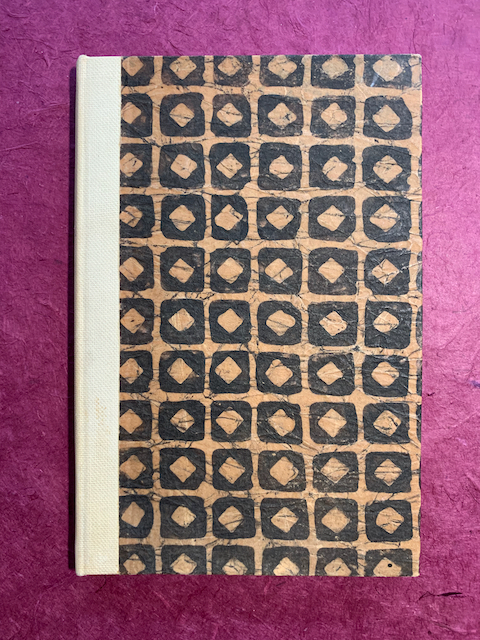
Cupid & Psyches: The Most Pleasant & Delectable Tale of Their Marriage. Engravings by Lettice Sandford
Apuleius (124-170 CE). William Adlington (fl. 1566) translator Small 8vo. 7 3/4 x 5 1/4 inches. (48) pp. Colophon, engraved frontispiece, title page with cockerel vignette in black, 2 wood engravings in the text; text unmarked, water-staining in lower margin at pages 26-44. Cream cloth spine, patterned paper over boards, spine titled in gilt; binding square and tight, light shelf wear and soiling to spine. GIL921-021. SCARCE. Very Good. LIMITED EDITION of 150 copies, this is number 123. The text in this volume comes from the Golden Asse of Apuleius, translated by William Adlington (London, In Fleetstreate, at the sign of the Olipante, by Henry VVykes, 1566). Lucious Apuleius Madaurensis (circa 124 to circa 170 CE) was a Numidian Latin-language prose writer, Platonist philosopher, and rhetorician. His most famous work is his bawdy picaresque novel, the Metamorphoses, otherwise knows as The Golden Ass. It is the only Latin novel that has survived in its entirety. It relates the ludicrous adventures of one Lucius, who experiments with magic and is accidentally turned into a donkey. Lucius goes through various adventures before he is turned back into a human being by the goddess Isis. Within this frame story are found many digressions, the longest among them being the well-known tale of Cupid and Psyche. This story is a rare instance of a fairy tale preserved in an ancient literary text. The Golden Cockerel Press was an English fine press operating between 1920 and 1961, during which time a number of proprietors operated the press. The Golden Cockerel Press was founded by Harold (Hal) Midgley Taylor (1893-1925) in 1920. The third ownership partnership was formed in 1933 when the press was taken over by Christopher Sandford (1902-1983), Owen Rutter, and Francis J. Newbery. Around this time the Golden Cockerel Press ceased to be a private press and became a publishing house. Sandford worked long hours on management, editing and design. Rutter solicited new books and edited some of them. Newbery's role as the printer was to oversee the production work at the Chiswick Press. The illustrator of this volume was Lettice Sandford (1902-1993), Christopher Sandford's wife. She was a draftswoman, wood-engraver, pioneer corn dolly revivalist, and watercolorist, as well as the mother of playwright Jeremy Sanford. She provided wood engravings for many Golden Cockerel titles. See Wikipedia for the information in this paragraph. Worldcat records 26 copies.- $250
- $250
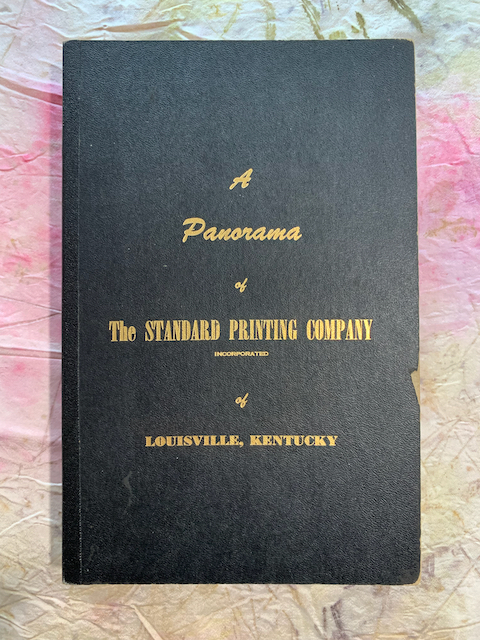
A Panorama of The Standard Printing Company, Incorporated of Louisville, Kentucky [Cover Title]
The Standard Printing Company, Incorporated 8vo-size Accordion-Fold. 8 7/16 x 5 1/2 inches. Unpaginated. [16] pp. 15 silver-gelatin photographic prints mounted on each page with a caption of the printing equipment displayed, the last page is a printed list of companies: "This equipment is being used to produce printed material for many companies including"; text clean, unmarked. Gilt-stamped black leatherette, black cloth-backed adhesive provides the joints that hold the accordion-fold together; shelf wear. SCARCE. SS321-013. Very Good. UNIQUE? This volume contains a series of 15 silver-gelatin photographic prints showing the modern print shop created by The Standard Printing Company, Incorporated. The equipment on display was available in the 1950s. One imagines that this accordion-fold presentation volume was used as a tool Standard's salesman would use when visiting a potential client to demonstrate Standard's modern equipment and list of high-end clients. Not in Worldcat.- $250
- $250
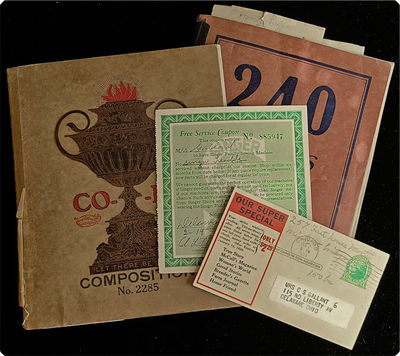
Manuscript on paper, in English.
Gallant, C[harles] S[purgeon], Mrs. Delaware, OH, 1929–30 & 1937–38 Delaware, OH, 1929–30 & 1937–38. 4to (21.27 cm, 8.375"). 2 vols. I: [84 (78 used)] pp. II: [240 (100 used)] pp.. Early 20th-century Ohio life captured in a wealth of minutiae: Two volumes of a journal kept by an older, middle-class woman, offering daily records of her sewing, quilting, baking, cooking, canning, churchgoing, aid society efforts, and other domestic activities, along with descriptions of the weather and references to current events (including a passing mention of one of the worst prison fires in American history: the 1930 Ohio State Penitentiary fire, in which 320 prisoners were killed) — all recorded in two different composition books. Notable threads trace => a powerful lot of visiting, in (and from) the Gallant house — those familiar with family names of the region will find much to recognize here; references to operations on nearby => family farms; and detail relating to Mrs. Spurgeon's domestic operations — hers was a "comfortable" life, set within a clearly comfortable home, but it was => very hardworking. Small "touches" intrigue; a visitor calls before going out to India; Mrs. Spurgeon hears a preacher who, 100 years old at the time, had been a chaplain "in the Rebellion"; there is a note in once place of a rental of "my" house (not "our" or "the" house) ~ did she independently own this property? Laid in are numerous newspaper clippings, mostly recipes and crochet pattern advertisements, as well as a message card from a florist (Gallant seemed particularly fond of flowers, and often noted not only receiving bouquets but what they were composed of), song lyrics for "Help Somebody Today," a Singer sewing machine service coupon, handwritten recipes, and other miscellaneous tidbits including a slip of paper bearing only the pencilled words "Free Booklet [/] Should Husbands Keep House." Gallant also used these two volumes for bookkeeping, flipping the first upside down to use the back pages for detailed records of expenses, and leaving a separate memorandum booklet used for the same purpose in the second — expenses including "electric bulbs and shades," "Pickles and Beans" from a "Pedlar," and "missionary dues." In the last eight pages of the second volume, the handwriting changes completely (mid-sentence!); Mrs. Spurgeon's previous entry mentions "not feeling very well, Charlotte with me" — and it's tracking Charlotte, who appears to have taken dictation for some final entries while adding notes of her own — that allows us fully to identify Mrs. Gallant and put context to this manuscript. From cross-checking noted relationships and internet follow-up, it appears that Charlotte was a granddaughter; she achieved Phi Beta Kappa at Ohio Wesleyan and, among other things, was a pianist. In 2017 she was 100 years old and living in Delaware, Ohio's Willow Brook retirement community, appearing in the news as having donated to the county 83 acres of property that had belonged to her grandfather. This parcel, with additions, was to form the basis of the Gallant Woods Park — neighboring the => Gallant Farm Preserve, which showcases life in the period of these diaries. On the Gallant Park and Farm Preserve, see: https://preservationparks.com/parks/gallant-woods/ and https://preservationparks.com/parks/gallant-farm/. Publisher's printed paper wrappers; spines and edges rubbed, one spine chipping and one reinforced with cloth tape. Some pages with offsetting from laid-in items, otherwise clean. => Impressive amounts of data, and quite a lot of atmosphere, illuminating the life of an Ohio woman of this time in midwestern America.- $185
- $185
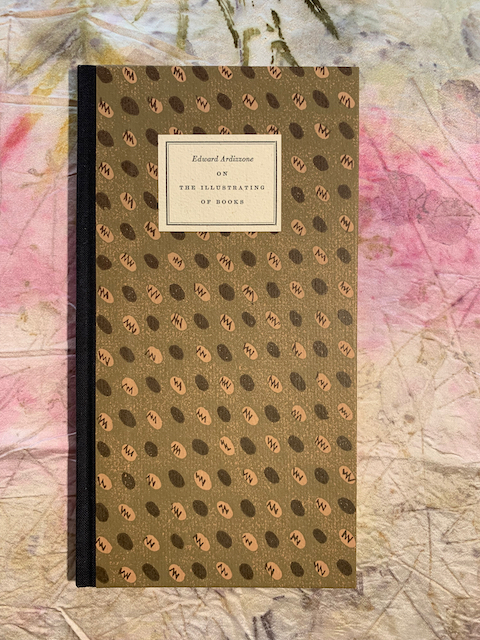
On the Illustrating of Books. From The Private Libraries Association Quarterly, July, 1957
Edward Ardizzone (1900-1979) Narrow 8vo. 8 1/2 x 4 9/16 inches. [x], (14 last blank) pp. Half-title, title-page vignette, 4 illustrations in the text; text clean, unmarked. Quarter black cloth, patterned paper over boards, printed paper front cover label, sewn head-bands, no dust-jacket; binding square and tight. SCARCE. SBRB921-001. Very Good. LIMITED EDITION of 200 copies printed with Linotype Scotch on Rives buff wove paper, illustrations by Edward Ardizzone, bound by Bela Blau. "Unlike his contemporaries, Bawden, Freedman, and Ravilious, Ardizzone was not touched by cubist influence and, by comparison, their sophisticated styles make his work appear to be almost naive or quant. Ardizzone's work is always warm with classicism and touches of Rowlandsson, and somehow seems familiar to us." From Vance Gerry's Introduction. Edward Jeffrey Irving Ardizzone was an English painter, print-maker and war artist, and the author and illustrator of books, many of them for children. Wikipedia. REFERENCE: Butcher, "Checklist," in Vance Gerry & The Weather Bird Press, No. 80.- $300
- $300
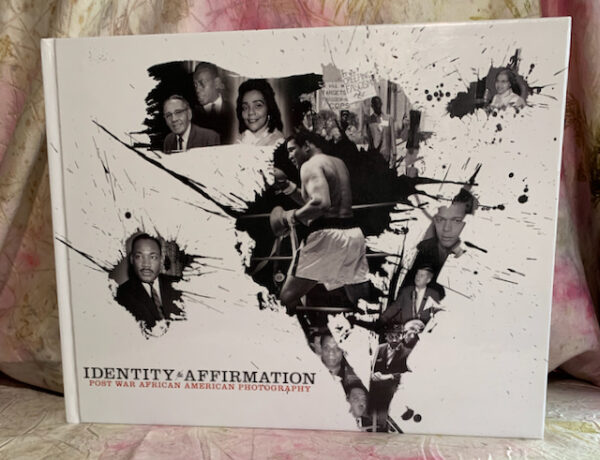
The Institute for Arts & Media, California State University, Northridge
Identity & Affirmation: Post War African American Photography Oblong 4to. 9 13/16 x 11 1/4 inches. 112 pp. Illustrated throughout with color and (mostly) black-and-white photographs; text clean, unmarked, except the inscription on the title page. Illustrated boards; binding square and tight. Faculty business card of Keith Rice, historian and archivist at the Tom & Ethel Bradley Center at CSUN, and INSCRIBED by Rice on the title page. LAWO921-021. Fine. FIRST EDITION of this exhibition catalog which took place at the CSUN University Galleries, October 23 through December 10, 2011. The Tom & Ethel Bradley Center has over one million images produced by Los Angeles-based photographers that document the social, cultural and political lives of the diverse communities of Los Angeles and the Southern California region between the 1920s and the present. The archives contain one of the largest collections of African American photographers west of the Mississippi and the most extensive collection in Southern California. The exhibition of the Bradley Center's photographs that took place on the SCUN campus in 2011 focuses on the African American experience in post-World War II Southern California. Inscribed by the exhibition curator, Keith Rice, historian and archivist at the Bradley Center.- $100
- $100
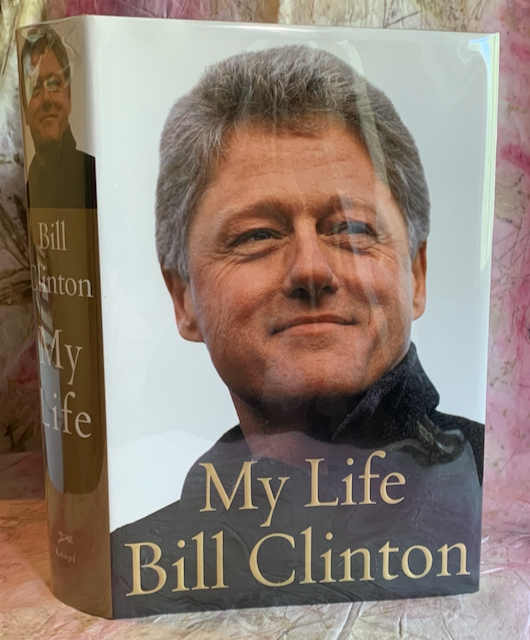
My Life
William Jefferson Clinton (b. 1946) Thick 8vo. 9 1/2 x 6 1/4 inches. [vi], (958), (xliv) pp. Numerous black-and-white half-tone photographic illustrations on plates, index; text clean, unmarked. Blind-stamped blue boards, spine titled in gilt, dust-jacket in archival mylar; binding square and tight. SIGNED by Bill Clinton on the title page. LAWO921-002. Fine. FIRST EDITION, first state, with the last line of the acknowledgements reading "for the failure of my life," p. iv. "Bill Clinton is an American politician and attorney who served as the 42nd president of the United States from 1993 to 2001." "My Life" is Clinton's 2004 autobiography, published by the Knopf Publishing Group which sold more than 2.3 million copies. Laid in is a postcard "Paid for by Ready for Hillary PAC," 2013. This copy SIGNED by the former president, showing evidence of the fatigue of a long book tour. This signature, while genuine, is a bit sloppy. Nevertheless, Clinton received his reward not in the end, but in the beginning - a $15 million advance from the publisher, the highest such fee ever paid by a publisher at the time. See: Wikipedia.- $125
- $125
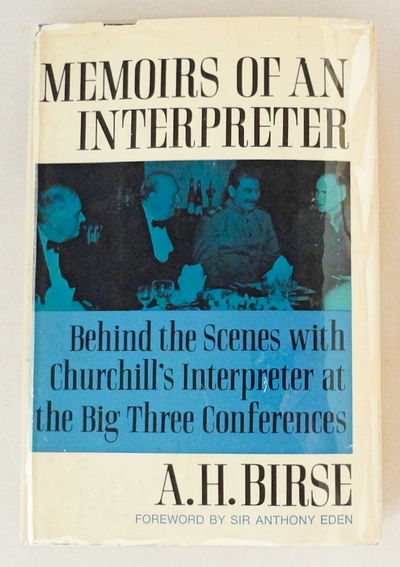
Memoirs of an Interpreter
Birse, A.H. New York, 1967 Hard cover in dust jacket. Octavo. 254 pages. Dark blue publisher's cloth with gilt titles to spine. A name and date written on title page otherwise clean and unmarked. Price clipped dust jacket shows shelf wear with light chipping to top edge and is protected in a new archival quality mylar sleeve. A.H. Birse accompanied Churchill as his Russian interpreter for the Big Three meetings with Stalin and Roosevelt in Yalta, Potsdam and Teheran. His keen, firsthand observations give enormous impact to his candid account of the personalities and happenings of these times.- $100
- $100
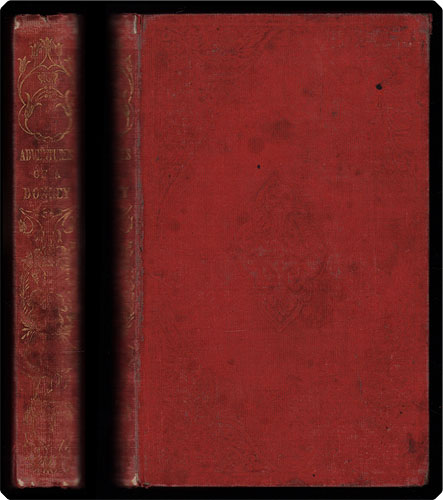
The adventures of a donkey.
Argus, Arabella. Life from a donkey's perspective, including misadventures at the hands of cruel children, dishonest servants, and roaming Roma. This edifying children's work, intended to open readers' eyes to the suffering endured by working animals, appears here => illustrated with a frontispiece and numerous in-text vignettes; the date is suggested by the publisher's information. Provenance: From the children's book collection of Albert A. Howard, small booklabel ("AHA") at rear. 12mo (14.8 cm, 5.82"). Frontis., 213, [3 (adv.)] pp.; illus. Osborne Collection, p. 858 (for 1st ed.); this ed. not in Opie. Publisher's blind-stamped red cloth, spine with gilt-stamped title and decorations, all edges gilt; cocked, with hinges (inside) starting from head and foot, and tender. Spine dimmed, sides with small spots of discoloration, joints and extremities rubbed; minimal age-toning and a few scattered spots of foxing, pages otherwise clean. => A very readable copy of this interesting precursor to Black Beauty, and the animal in the illustrations is full of personality.- $100
- SessaBks |
- $100
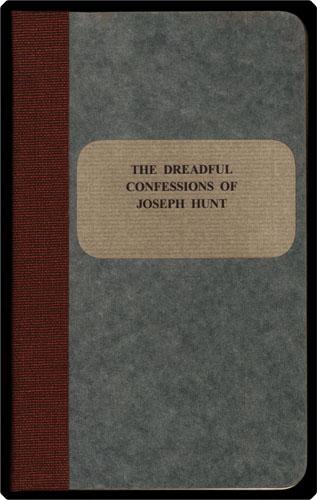
The whole of the dreadful confessions of Joseph Hunt, relative to the horrid murder of Mr. Weare.
Hunt, Joseph. Chapbook printing of Hunt's first-person confession, relating how he conspired with John Thurtell and William Probert to murder William Weare. Title continues "with the plans formed by the bloody-minded crew, for the annihilation of many other persons. => To which are added, faithful accounts of their hellish schemes and secret haunts." 12mo (17.5 cm, 6.75") 31 pp., lacks fold. plate. Disbound, now in plain wrappers, all edges gilt; folding plate lacking, one leaf with a marginal chip, and old exposure to water intermittently evident but not, as per title, "dreadful"! In a very good pamphlet folder.- $275
- SessaBks |
- $275
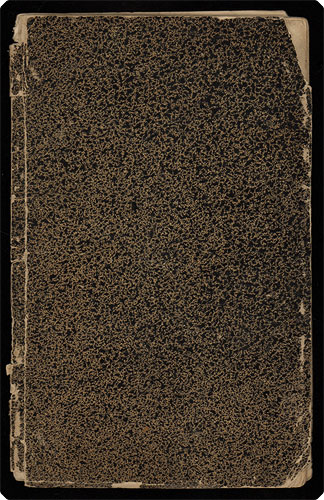
Dandyism displayed, or, the follies of the Ton; humbly dedicated (without permission) to a lord of the Willow-Boys; to the noble Sham-Peter & his white charger, prince of the dandy blood royal; and to that renowned son of Mars and Venus, the great captain . To which is added, What is a dandy?
Bisset, J. Uncommon chapbook: a sarcastic look at the manners and customs of dandies, addressed directly to a variety of subcategories including actors, booksellers, undertakers, staymakers, pastry cooks, and "salesmen and pawnbrokers of the Jewish persuasion" ? as well as to dandy concubines and "celebrated ladies of the Ton" including the Opera House Sisters, Mother Bang, and the Misses G ? y. This is the stated second edition, with => a frontispiece offering four sketches by George Cruikshank: a woman and man each shown in morning and evening dress. In this copy, the man in each pair has been brightly hand-colored with a fair amount of delicacy, leaving the woman uncolored. The work is rarely encountered in any form, with a search of WorldCat finding => no reported U.S. institutional holdings and vanishingly few overseas. Provenance: From the chapbook collection of Albert A. Howard, small booklabel ("AHA") at rear. 8vo (16.8 cm, 6.61"). Frontis., [2], [7]?28 pp. Cohn, George Cruikshank: A catalogue raisonn?, 221. Later speckled paper wrappers, rubbed and chipped, splitting at joints with covers essentially separated. Age-toned; offsetting from frontispiece to title-page. => Scarce, and worthy of recasing.- $450
- SessaBks |
- $450
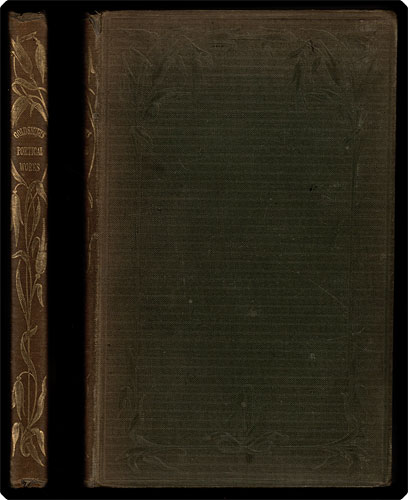
The poetical works.
Goldsmith, Oliver; Myles Birket Foster, illus. The ever-popular works of Goldsmith, here => illustrated with 30 engravings done by John Absolon, Birket Foster, James Godwin, and Harrison Weir. Provenance: Birket Foster's copy, presented by the publisher. Front free endpaper inscribed to Birket Foster, "with the publishers' compts." dated 1857; front pastedown with the artist's bookplate. The text and illustrations bear pencilled markings and annotations (mostly numerical), apparently => done by the artist. Most recently in the library of American collector Albert A. Howard, small booklabel ("AHA") at rear. 8vo (18 cm, 7.08"). Frontis., xvi, 134, [2 (adv.)] pp.; illus. Contemporary ribbon-embossed olive cloth, covers framed in blind-stamped flower and stem motifs, spine with same motif and title in gilt; spine and upper edges sunned to brown, extremities rubbed. Back pastedown with binder's ticket of Bone & Son. Pages gently age-toned, with pencilled markings as above; last few signatures unopened and two leaves with short edge tears. => An "association copy" of real interest.- $250
- SessaBks |
- $250
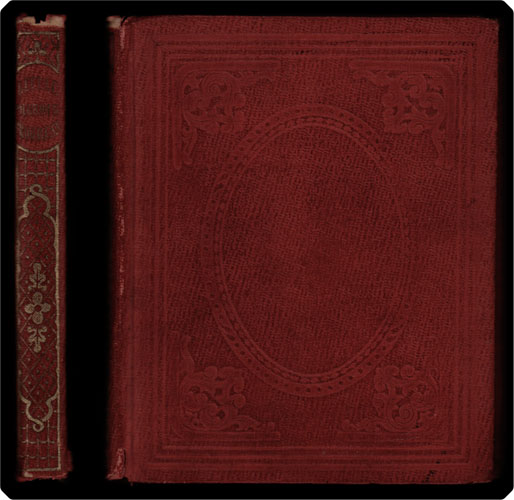
The little pilgrim’s progress.
Bunyan, John]. Children's treatment of the Bunyan classic, here => illustrated with a wood-engraved vignette on every other page. This mid-19th-century American edition is not widely held institutionally, with WorldCat finding only four reported U.S. locations. Provenance: Front free endpaper with early pencilled ownership inscription of Jane E. Brewster and with rubber-stamp of a Rochester, NY, bookseller. Most recently in the children's book collection of Albert A. Howard, small booklabel ("AHA") at rear. 16mo (11.8 cm, 4.64"). 96 pp.; illus. Publisher's blind-stamped red cloth, spine with decorative gilt-stamped title and embellishments; extremities and joints rubbed, spine slightly sunned. Pages faintly age-toned with a few scattered small spots of foxing; clean. => A nice copy.- $100
- SessaBks |
- $100
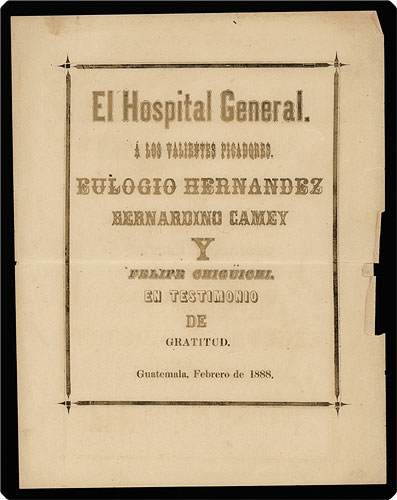
El Hospital General ? los valientes picadores, Eulogio Hernandez, Bernardino Camey y Felipe Chig?ichi. En testimonio de gratitud.
El Hospital General San Juan de Dios de Guatemala. Bullfighting and hospitals are usually linked by harm and remedy: the harm occurring in the bull ring and the remedy that hospitals can provide for that harm. But the Hospital General San Juan de Dios de Guatemala, founded in 1667 by the Orden Hospitalaria de San Juan de Dios (i.e., Hospital Order of San Juan de Dios), in the 1880s had a most unusual link to the Plaza de Toros in Guatemala City. It had taken it on to restore and maintain the colonial-era ring, and it became a popular site not only for corridas but for the circus and other forms of entertainment ? with the Hospital receiving income from all such uses of the Plaza. Special homage is paid in this handsome and rare broadside to three picadores who participated in what we suspect was a Corrida de Beneficencia, a benefit bullfight, in early 1888. => Entirely printed in gold, the text of the broadside is center justified, employs eight typefaces, and is contained in a gold frame. Folio (33.5 x 26 cm; 13.25" x 10.15" ). [1] p. Very good, some chipping in margins. Horizontally folded in the past without damage to the "joint."- $800
- SessaBks |
- $800
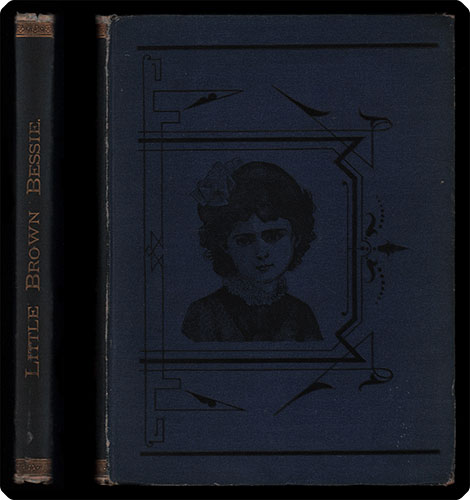
Little brown Bessie.
Ware, F. E. [pseud. of L.D. Shears]; Frank Beard, illus. First novel-form edition: Complicated romance set in a Massachusetts village, with plot threads involving a lost baby, a mysterious artist, a celebrated tenor plus a jealous soprano, and the Cinderella figure of the title, who rescues herself by running away to Boston ? among other excitements! The author originally published the piece in 1874 as a four-act drama; in the preface to this reworked novel version, she claims that the titular plotline was based on her own experiences growing up along "the old Housatonic" in Sheffield, MA. The tale is => illustrated with 16 engravings by influential cartoonist Frank Beard (once dubbed "the father of the American cartoon"), some full-page and some in-text. This first edition is intriguingly uncommon in libraries: A search of WorldCat finds => only two U.S. institutions reporting hard-copy holdings. The short-lived publisher was known not for books but for issuance of => a ladies' fashion magazine offering both style tips and patterns! Provenance: Front fly-leaf with 19th-century pencilled inscription of Guilford D. Eggleston. 4to (19.2 cm,7.55"). [2], 174 pp.; illus. Not in Wright, American Fiction. Bound as above; slightly cocked, spine and outer edges darkened, extremities rubbed. A handful of scattered small spots of foxing, pages otherwise clean.- $125
- SessaBks |
- $125
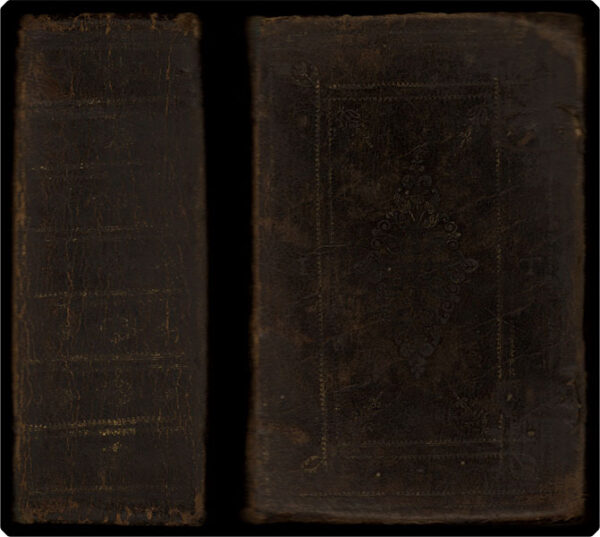
Biblia sacra veteris et novi testamenti, iuxta vulgatam editionem maiori qu?m antehac unquam doctorum studio, ad veritatem Hebraicam & probatiss, exemplarium fidem emendata.
Bible. Latin. 1574. Vulgate. Pierre Saint-Andr? gave this reissue of Fran?ois Estienne's 1567 edition a new title-page; the separate title-page of the New Testament bears both the original imprint, "Ex Officina Francisci Stephanj. M.D. LXVII," and the => Stephanus woodcut device. F. Estienne II, son of Robert I, seems to have been left wealthy by his famous father; he printed a small number of items from 1562 onward, apparently as the mood struck him, with one gap of more than ten years. The date of his last imprint was 1582, and he left Geneva sometime thereafter. The text of the present production, which makes use of Robert Estienne's verse divisions, is printed in double columns with decorative headpieces and capitals and is => illustrated with 22 in-text vignettes (although the folding map is not present here), including Noah's ark and the tabernacle with its furnishings. Binding: Contemporary calf, covers framed and panelled in gilt-stamped beaded rolls surrounding a central gilt-tooled diamond-shaped medallion; corners with gilt fleurons, spine with gilt-stamped beaded bands and compartment decorations. All edges gilt, and remants/evidence of clasps present. Provenance: One leaf with early inked inscription reading "ex dono Joseph Rowens"; later bookplates of the James Buckham Memorial and Charles Holbrook libraries at the Pacific School of Religion (Berkeley, CA). Evidence of Readership: Title-page with traces of mostly effaced early inked inscription; blank leaf between Old and New Testaments with one small early inked word, lined through; occasional early marks of emphasis and underlining in red, one early marginal note. 8vo (16.7 cm, 6.57"). [8], 435, [1], [1]?131 (i.e., 113), [27] ff.; illus. (fold. map lacking). Darlow & Moule 6160. N.T.: Adams B1075; Renouard (2nd ed.), Annales de l'imprimerie des Estienne, p. 159. Bound as above, with most gilt significantly rubbed and dimmed; rubbed and scuffed overall but solid. Endpapers refurbished some time ago; front pastedown and free endpaper with PSR bookplates affixed as above, these bearing small rubber-stamps affirming the volume's proper deaccession. First few leaves crumpled, final leaf rumpled and partially adhered to rear free endpaper; one leaf with small hole affecting a few letters; some upper edges trimmed closely, touching headers and leaf numbers; a handful of corners torn away not touching text. Old waterstaining affecting the text block?s final third, very light to begin with, darkens significantly across the last portion with the last few leaves and rear endpapers showing onetime action of mold long since stabilized; otherwise only the light soil as of ordinary use is occasionally apparent, with a few scattered small ink stains. A volume that obviously has seen much service and is priced accordingly, while yet => a sturdy, usable, and interesting copy of a noteworthy Bible.- $1,000
- SessaBks |
- $1,000
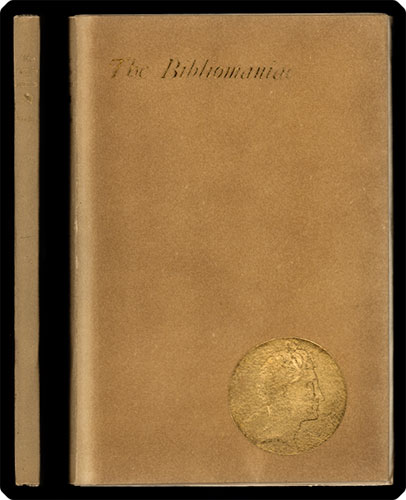
The bibliomaniac.
Nodier, Charles; F. Noel, illus.; Mabel Osgood Wright, transl. First edition in English: a handsome production of Nodier's wry tribute to a bibliophilia so extreme it proves fatal. The text opens with a preface by Ren? Vallery-Radot, and is => illustrated with two full-page portraits of the author and 24 in-text vignettes wood-engraved by Noel after designs by Maurice Leloir (note that the original title-page wrongly states 45 illustrations, corrected by the publisher in the material described below). This is numbered copy 150 of 150 printed on Japan paper by => the De Vinne Press, with a presentation card from the publisher as well as an erratum notice for subscribers and the corrected title-page leaf to which it refers, all laid in. Binding: Publisher's faux vellum wrappers in tan paper dust jacket with gilt-stamped title and medallion, in original slipcase. 8vo (21.1 cm, 8.3"). Frontis., 79, [1] pp.; illus. Bound as above; wrappers creased, jacket with medallion slightly rubbed and spine sunned, case showing moderate shelfwear overall but still sturdy. Pages clean and crisp. => Quite a nice copy, with nice lay-ins.- $350
- SessaBks |
- $350
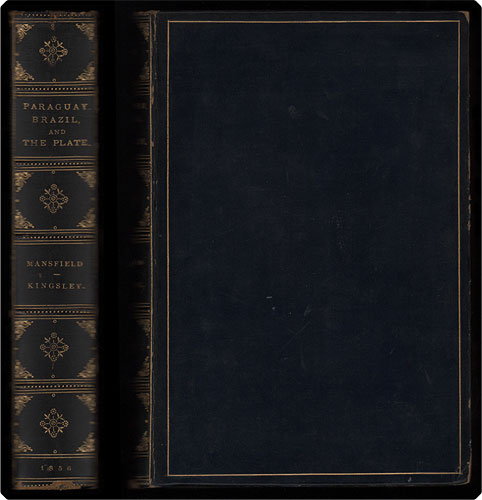
Paraguay, Brazil, and the Plate. Letters written in 1852?1853.
Mansfield, Charles Blachford, & Charles Kingsley. Posthumously published first edition, including a sketch of the author's life by Kingsley along with a map, portrait, and illustrations. According to the DNB, Mansfield was one of the earliest Englishmen to visit the capital of Paraguay, and "certainly the first to go there merely to take notes"; he has a number of thoughts regarding the future of South America, while the DNB highlights the "bright and careful descriptions of Paraguayan society, the scenery, plant and bird life" contained in these letters, which include similar entries for the other stages of Mansfield's travels. Binding: Contemporary dark blue calf, covers framed in single gilt fillet, spine with gilt-beaded raised bands and gilt-stamped floral compartment decorations. Board edges and turn-ins with gilt rolls. All edges gilt; endpapers of striking blue and gilt marbled paper. 12mo (18.6 cm, 7.32"). Frontis., xxi, [1], 504 pp.; 1 fold. map, illus. Palau 149416. On Mansfield, see: Oxford Dictionary of National Biography (online). Bound as above, spine slightly dimmed, extremities rubbed. Ownership marking (?) at foot of half-title and pencilled annotation on title-page both now almost completely effaced. Pages faintly age-toned with leaves prior to text (only) showing a few instances of foxing; otherwise, a very clean and fresh copy and one with => the folding map in excellent condition.- $650
- SessaBks |
- $650
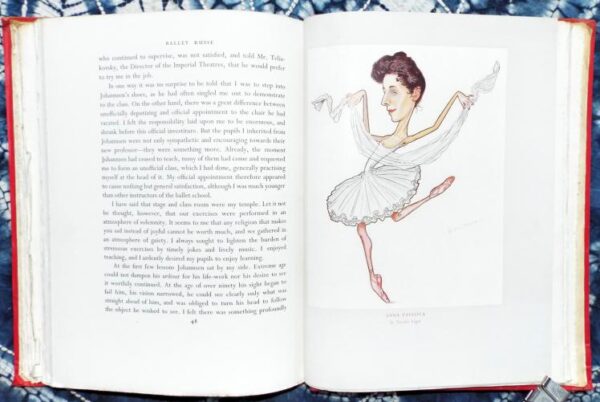
Ballet Russe, Memoir of Nicolas Legat Translated and with a Foreword by Sir Paul Dukes. Dedicatory Poem by John Masefield.
Legat (Nicolas)). 4to, publisher's red cloth, backs strip faded and a little rubbed at head, untrimmed. ppxv, 67, with 7 plates in colour and 24 "monotone". Very light foxing to a very few leaves. Masefield's dedication with printed signature. First Edition. The 3 appendices pay tribute to Pavlova, and list ballets in which Legat appeared, and those he produced. "He lived with one ideal. to transmit his learning to succeeding generations and keep alight the torch. (of) St Petersburg in the last decades of the Ninetenth Century" (Foreword) both as performer and later as teacher and ballet master.- $126
- $126
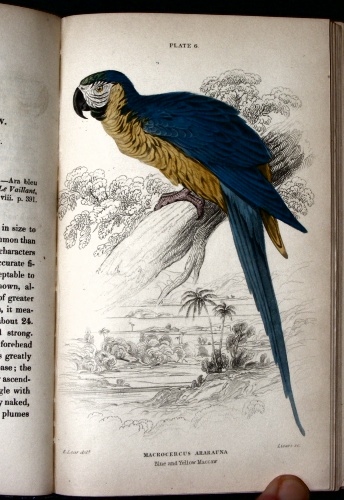
Parrots.
Jardine: Later grey cloth, uncut. Engraved portrait, coloured -title-page, 30 hand-coloured engraved plates after Edward Lear. One plate just trimmed (African Grey), otherwise good margins. The issue with the hand-coloured parrots against full engraved background scenery (not just a branch as in some late issues). Getting to be a difficult book to find. Series: Naturalists' Library.- $597
- $597
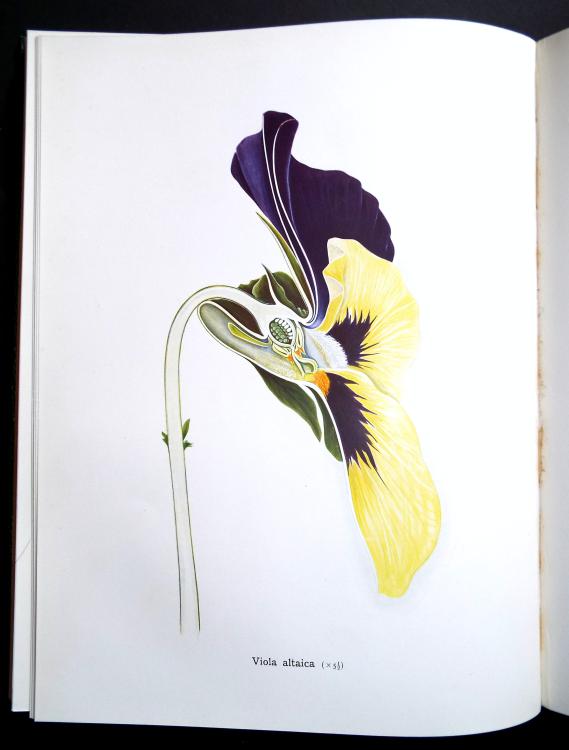
Types of Floral Mechanism A Selection of Diagrams and Descriptions of Common Flowers. Part 1, Types 1-XII. (All Published).
Church (Arthur Harry). Substantial 4to (10 x 10 3/4 ins, 250 x 320mm) very small and faint dark mark to backstrip, otherwise Fine Condition in publisher's green pebble cloth, backtrip gilt. pp vii, 211, monochrome plates, text illustrations and 39 extraordinary colour-printed plates, after Church's paintings. A project of "The Hundred Best Flowers" was proposed (intro), but after disagreements with Clarendon, Part 1 was all published, although he continued working on it until 1915. "An attempt has been made to strike a mean between prosy abstruseness. and imaginative flights." "Some of the finest (coloured illustrations) produced in modern times. their strikingly bold, almostJugendstil, images were used on greetings cards in the 1980s." ODNB quoting Mabberley's biography.- $414
- $414
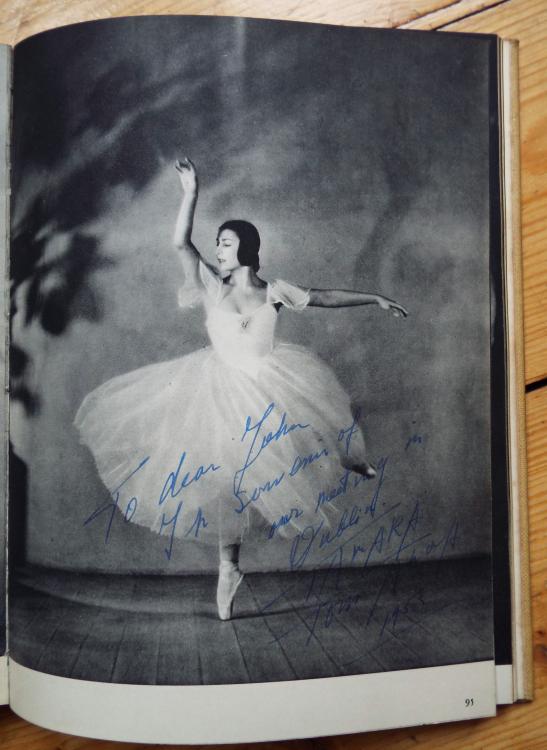
Ballet -To Poland. Decorated by Kay Ambrose. In Aid of the Polish Relief Fund.
Haskell (Arnold L.) Ed: Tall 4to (7 1/2 x 10ins, 200 x 250mm) bright in original buckram cloth with gilt lettering and motif to top cover. pp (154). Very light foxing to a few leaves. Essays and letters from the great and the good of contemporary ballet and theatre - Geligud, Masefield, Schaverell Sitwell, Victor Dandré, Ninette de Valois, Constant Lambert, W de.Basil et al., illustrated throughout with text illustrations by Kay Ambrose and plates after McKnight Kauffer, Pavlova, Felix Topolski, Oliver Messel, Cecil Beaton et al., some never before published. "Abums" of photographs, some pp58, of the greatest performers - Helpman, Fonteyn, Pavlova, Nijinski, and stars of the Russian and Polish ballets. "This Edition is limited to One Hundred copies. This is No.26" and signed by Haskell and Ambrose. Additionally in this copy 4 of the photographs have been autographed :Tamara Toumanova 1954, Pamela May, June Brae, Margot Fonteyn.- $274
- $274
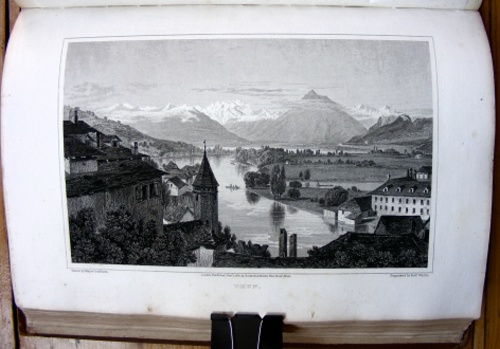
Swiss Scenery.
Cockburn (Major.) 4to (7.5 x 10 3/4, 190 x 270mm) contemporary half calf, gilt, top joint a little worn and split at head of backstrip. Engraved title-page, 60 steel plates. A little foxing (mainly marginal) and occasional offset. "Carefully and truthfully drawn, architecture correct in its proportions" DNB. A European tourist since the age of 13, Batty served under Wellington in both the Peninsular war and Waterloo campaign.- $407
- $407
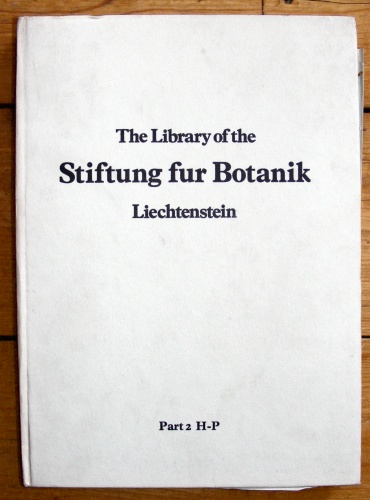
The Magnificent Botanical Library of the Stiftung fur Botanik, Vaduz, Liechtenstein, Collected by the Late Arpad Plesch. Parts 1-3 Complete.
Plesch Library: 3 volumes 4to, original boards, minor bump to one corner, otherwise, clean and fresh. Many plates, some coloured. 863 lots, all fully described, many with copious bibliographical notes, with buyer's names and price lists. Usually found with dusty or soiled covers, this is an excellent copy of one of the finest botanical libraries at auction.- $211
- $211
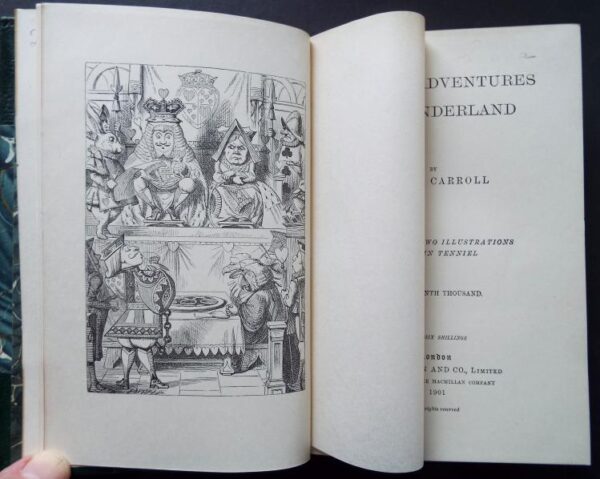
Alice’s Adventures in Wonderland. With Forty-Two Illustrations by John Tenniel. Together with: Through the Looking-Glass and What Alice Found There. With Fifty Illustrations by John Tenniel.
Carroll (Lewis), Rev.Charles Dodgson. Uniformly finely bound in contemporary three-quarters dark green morocco, marbled sides, backstrips with raised bands, 5 panels, gilt with a rose motif, top edges gilt. Alice: half-title, frontispiece, pp (viii), 192. Through the Looking-Glass: half-title, leaf of the chess game, frontispiece, (ix), 224. Both volumes have a leaf Christmas Greetings (From A Fairy To A Child.) dated 1887, paginated 195 in Alice and 227 in Looking-Glass and bound-in at the end, the intervening blank having been removed in rebinding. Williams 162. A Fine Pair, with the bookplate of Louise Whitfield Carnegie, wife of Andrew Carnegie. The couple "jointly helped the creation of over 2,500 libraries between 1883 and 1929." Wikipedia.- $842
- $842
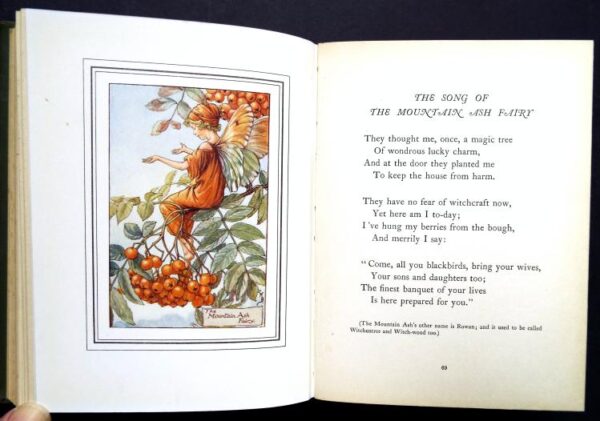
The Book of Flower Fairies.
Barker (Cicely Mary) Publisher's green cloth, gilt, untrimmed and complete with the 72 colour-printed Flower Fairy plates plus text illustrations. Front end-paper neatly cut out, free end-paper affixed to inside cover, neat inscription to foot of half-title. Bright, crisp copy. An early issue, the plates with their decorative ruled borders and the tallest format (6 x 7.5 ins, 145 x 190mm). A compilation of Flower Fairies of the Spring, Summer and Autumn.- $168
- $168
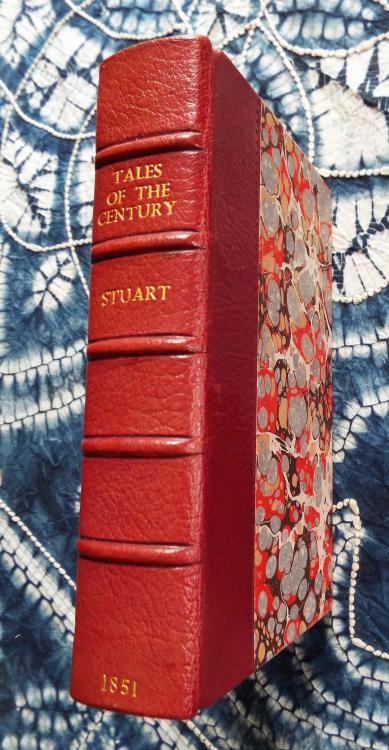
Tales of the Century or Sketches of the Romance of History Between the Years 1746 and 1846.
Sobieski (John) and Charles Edward Stuart, otherwise John Carter Allen or John Hay Allan, and Charles Manning Allan or Charles Stewart Hay Allan. Nicely bound in generous modern quarter dark red morocco, raised bands, gilt, marbled sides, all edges gilt. Lithotint frontispiece (joint between it and title-page slightly split), ppxii, 230 (Tales), 1-300 (various Notes). First Edition. A series of tales and jottings "credible because (they are) improbable" (intro) by the remarkable Sobieski Stewarts, the "de jure monarch(s) of England in place of the then reigning sovereign Queen Victoria", claiming to be, quite without justification or evidence, the Grandsons of the Pretender. Their claim drew the support of men of rank and intelligence, but was "absolute fabrication" (Walter Scott), who suggested that they were "men of warm imaginations . of much accomplishment but little probity". "Shot through with pure fantasy and bare faced forgery." Trevor-Roper. Chapters include The Prince's Long Incognito and The Arrest of Charles Edward.- $274
- $274
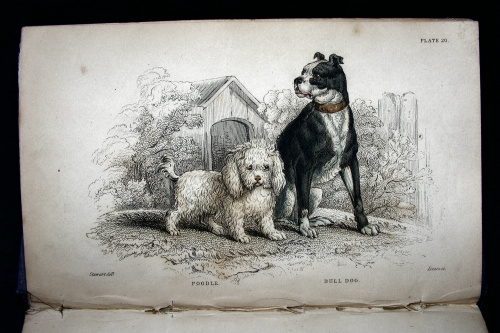
Dogs.) Mammalia.Canidae. Volume 2 (Volume X of Mammalia).
Jardine (Sir W.) Later grey cloth, part of original backstrip retained as label. Engraved portfait, title, 4 uncoloured plates, 31 hand-coloued steel engraved plates, this First Edition with the uncoloured backgrounds. A little light browning, overall good conditon . Volume 2 illustrates and describes mostly domestic dogs, their wild ancestors being in Volume 1.- $211
- $211
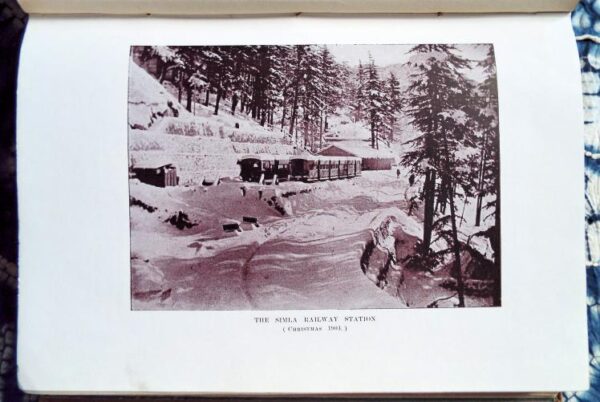
Simla Past and Present. With Illustrations.
Buck (Edward J.) Substantial Royal 8vo (7 1/2 x 10ins, 190 x 260mm) publisher's printed buckram, beveled edges, untrimmed, lettering on backstrip faded, carefully recased. pp xiv, 270, advertisement leaf. Folding map, 51 plates, mostly after photographs, a few leaves discoloured or slightly foxed. Only Edition. With an early photograph of Simla noting several places on verso, and an early typed pp5 essay by Sita Ram Kohli on the Trial of Diwan Mul Raj, Governer of Multan.- $316
- $316
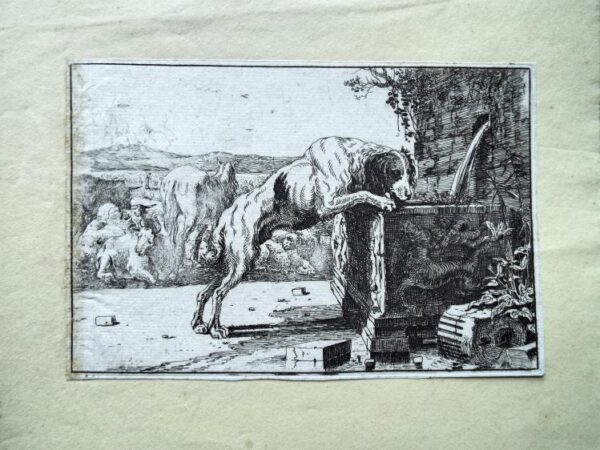
The Zoographia (Descriptions of Animals) Known as.
Hecke (Jan van den). A Collection of 9 etchings, each approx 165 x 110mm, 6.5 x 4.5ins, with ruled margins (none trimmed), mounted up to 8.2 x 6.7ins, 270 x 170mm on contemporary straw coloured paper, the plates just edge mounted on one side or corner, several now loose, all in good condition, clean and fresh, now protected in a custom case. The full suite is 12, we have 1-2, 4-5, 7, 9-12. Dedication on Plate 1 "Magnificentissimo principi Paulo Iordano Bracciani duci. fecit aqua forti Johannes vanden Hecke". Delightful, sensitive and humorous etchings, delicately illustrating farm and domestic animals - dogs (4), horses, donkeys, cattle, sheep, a stray squirrel - in a mixture of ruined classical and dilapidated rustic farmyard settings. Working firstly in Antwerp, later Brussels before finally returning to Antwerp, Van den Hecke visited Rome on several occasions between 1644 and 1658, that classical influence being evident in these lovely etchings. He was particularly noted for his canvases of flowers, plants and his still lives, his patron the Duke of Bracciano being a celebrated collector.- $1,544
- $1,544
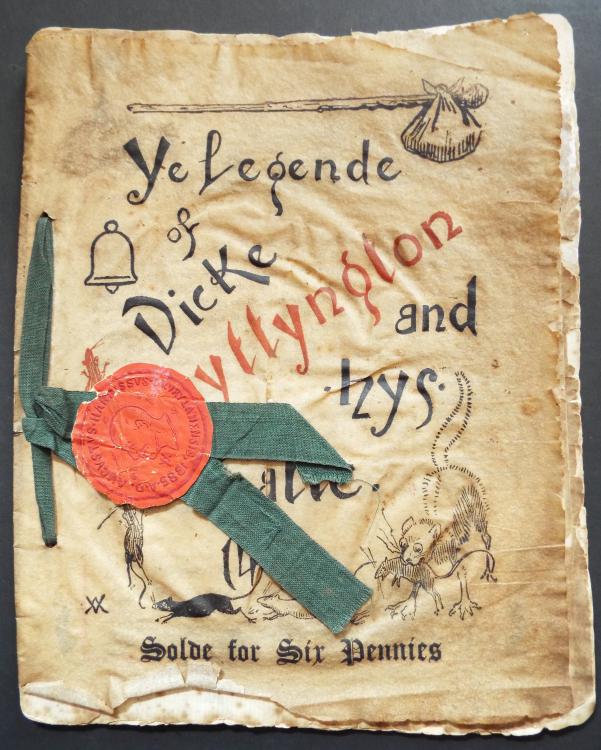
Ye Legende of Dicke Whyttington and hys Catte. 1420. Solde for Six Pennies. Ye Wrytinge of Ye Legends bye Horace Lennard. Ye Pictures bye Wallis MacKaye.
Lennard (Horace). 4to (8 3/4 x 11ins, 220 x 275mm) original deliberately aged vellum covers (now rather brittle), printed red and black, original green linen ties with red paper seal, printed with portrait of Augustus Harris, the completely untrimmed edges now rather more worn than even the the distressed original. Tipped-in notice explaining this re-imagining of the legend, pp (16), final leaf listing Harris' pantomimes at Crystal Palace, and Theatre Royal Drury Lane. Illustrated throughout in red and black to accompany the verse text. Marginal foxing. A rare survival, 2 copies recorded in the UK, 2 in US, 1 in Amsterdam. Son of a famous theatrical manager father, also Augustus Frederick Glossop Harris, following some years of successful acting, producing and management in music hall and theatre, Augustus junior leased the Theatre Royal in Drury Lane, his celebrated and popular pantomimes subsidizing Opera productions such as the first production of Meistersinger, and Tristan and Isolde (first outside Germany), as well as other less popular pieces whose plots were "long and bewildering". The pantomimes cast Dan Leno, Vesta Tilley, Marie Lloyd, Little Titch, and both pantomimes and other productions were famous for their lavish scenery and parades, even involving Major Kitchener to arrange marching sequences. His innovations such as electric lighting, dark auditoriums during a performance, and courageously promoting Opera in languages other than Italian, set the standard of the day. Our Whyttington is no longer the innocent country lad, but a turbaned African youth, setting ashore at the white cliffs where John Bull has no cats. After being pulled up by Constable Bowbelles on Highgate Hill (a Victorian stop-and-search), the pestilential plague of rats is dispersed, and Dick's journey continues meeting William Booth, paying income tax to Gladstone, being entranced by his many visits to the Belles of the Drury Lane Theatre accompanying the Prince of Wales, and receiving honours from Queen Victoria. He returns home a rich man to his waiting sweetheart, founds a corporation, where he as Lord Mayor grew toothless old and fat, "And this is how ye stories run, which telle of Dyckie Whyttington".- $807
- $807
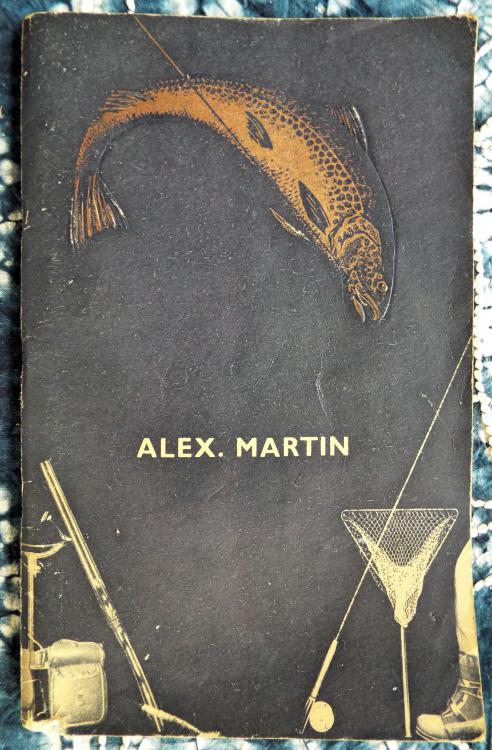
Fishing Tackle of Quality. 1938 Edition.
Alexander Martin: Original black and gilt stapled pictorial card covers - an embossed, gilt, hooked trout, and fishing tackle - Scottish fishing resort map to rear, very slight bump to lower edge. pp136, illustrated throughout, pp14 are in full colour - mostly flies and rods - includes shotguns and cartridges etc. Sticker tipped in from Stand T24 North of the Palace of Industry Exhibition, Empire Exhibition, Glasgow 1938, order form loose inside back cover. Game, Coarse and Sea fishing, rods reels, bags and every accesssory. An exceptionally nice catalogue in very good condition. The fourth generation, established over 130 years ago.- $105
- $105
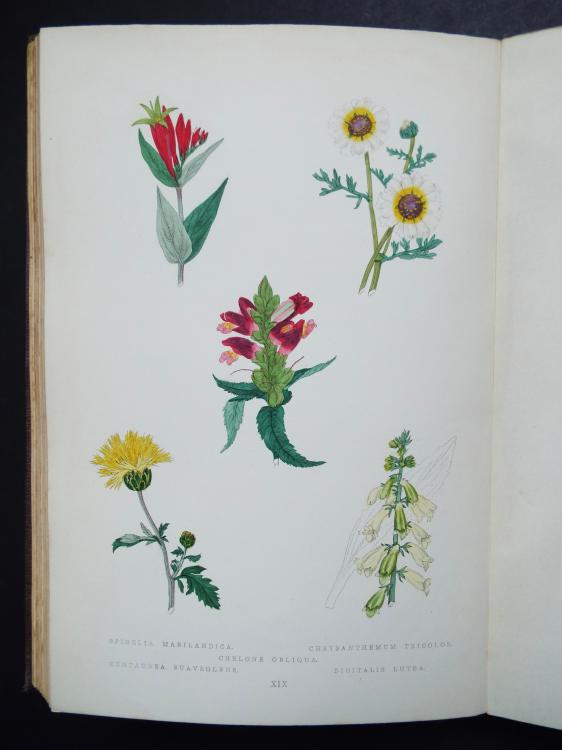
The Botanic Garden. Ed: J.C.Niven.
Maund (B.) 6 volumes Roy8vo (7 x 10in.,180 x 260mm) original mauve stamped cloth, gilt, chips and splits to backstrips of several volumes, untrimmed, so in the tallest possible state. 250 Hand Coloured Plates,arranged 5 to a page. Very sight and occasional spotting to untrimmed edges, otherwise internally a crisp set of the Second Edition. The usual issue of the First Edition is about 6 x 8 ins, 150 x 200mm, so considerably smaller page size, with 4 figures and ruled divisions.- $983
- $983
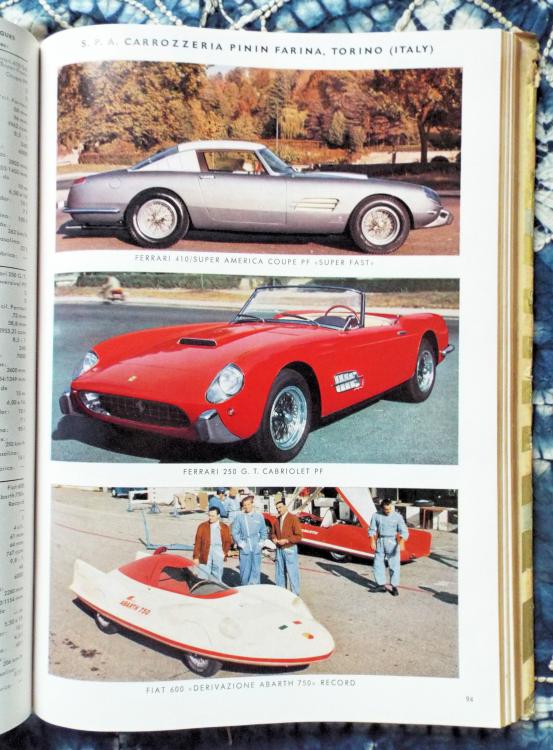
Internatioal Automobile Parade. (The same in German and French.)
Logoz, Arthur. Tall 4to (215 x 300mm, 8 1/2 x 12ins) publisher's cloth-backed printed boards, the fine photographic and gilt dust jacket "Auto-Parade" bright but with a few small chips missing. pp (ix), 291, 97 coloured photographic plates with 291 images. With the pink errata slip loose. Preface in English, French, German, Italian, Spanish and Portuguese. 2nd Edition or Volume 2. Exceptional copy. Italian, English, German, French, USA, Swedish, Czecho-Slovakian, Australian, Swiss and DDR cars make up this fabulous catalogue of stylish and fabulous automobile dreams. Full technical details including ex-works prices, and some road test reviews by "Phaeton".- $133
- $133
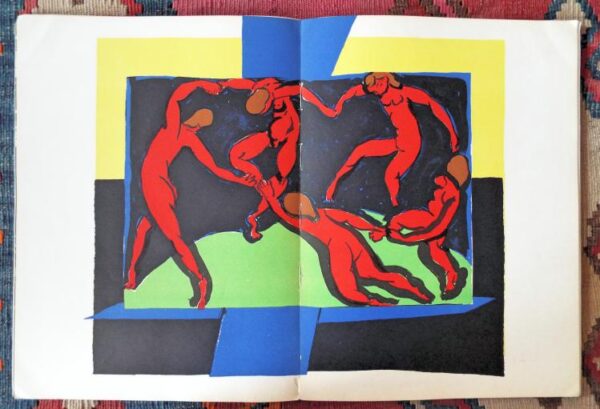
Verve. An Artistic and Literary Quarterly. (Volume 1) No,4. Director E.Tériade.
Verve: Folio 260 x 255mm, 10.5 x 14ins. Coloured stiff wrapper specially designed by Rouault, backstrip rubbed, internally very good. A Who's Who of the Fine Arts. Texts by Garcia-Lorca, Sartre, Paul Valéry. Marie Renard (model to Berthe Morizot (sic)), et al., reproductions, many in colour, of works by Rembrandt, Courbet, Lautrec, Miro, Rousseau, Rouault, Rubens, Doré, classical suites of "Grandes Heures" and medieval works finished in gold, Tintoretto, Degas, photographs by BrassaÏ, Bill Brandt (Gustav Doré's London Rediscovered series), Maywald (Seurat to Monet) et al. Original Lithographs: 8 original lithographs "Tacuinum Sanitatis Fourteenth Century Book of Health". Derain, Garden of Allah (6 pieces). Matisse, a specially commissioned double-page La Danse with 2 further lino cuts on versos (Figures of Skaters), 5 further reproductions of Matisse throughout. The English Language Edition, issued simultaneously with the French.- $695
- $695
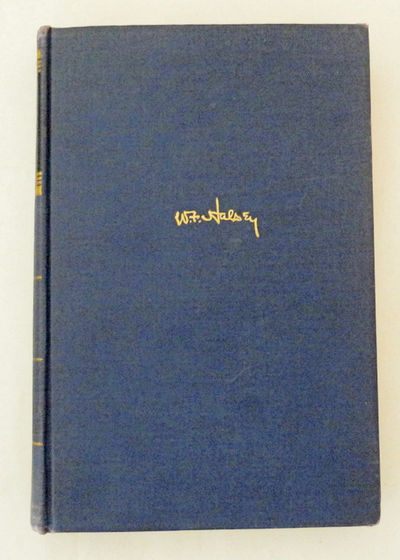
Admiral Halsey’s Story
Halsey, William F. Fleet Admiral U.S.N New York, 1947 Signed by author on half title page. Hard cover. Octavo. [xvii] 310 pp. Blue publisher's cloth over boards. Gilt titles to cover and spine. Map end papers. Illustrated with b/w photographs. Clean and unmarked. Light shelf wear to cover. No dust jacket. William Frederick Halsey Jr. was a fleet admiral in the United States Navy during World War II. He is one of four individuals to have attained the rank of fleet admiral of the United States Navy. Halsey was made commander of the South Pacific Area, and led the Allied forces over the course of the Battle for Guadalcanal and the fighting up the Solomon chain. In 1943 he was made commander of the Third Fleet, the post he held through the rest of the war. He took part in the Battle of Leyte Gulf, the largest naval battle of the Second World War and, by some criteria, the largest naval battle in history.- $225
- $225
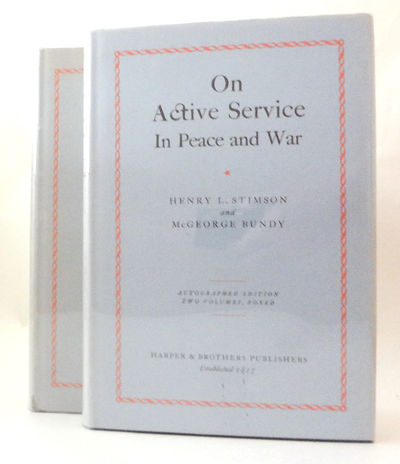
On Active Service In Peace and War
Stimson, Henry L. New York, 1948 Two volume set. Number 227 of a limited first edition of 1250 signed by the author on the limitation page of volume I. Hardcovers in blue publisher's cloth with dust jackets. Octavo. Both volumes clean and unmarked. Price clipped dust jackets show some shelf wear and fading to spines and are protected in archival quality mylar sleeves. Henry Lewis Stimson was an American statesman, lawyer, and Republican Party politician. Over his long career, he emerged as a leading figure in U.S. foreign policy by serving in both Republican and Democratic administrations. He served as Secretary of War (1911–1913) under President William Howard Taft, Secretary of State (1929–1933) under President Herbert Hoover, and Secretary of War (1940–1945) under Presidents Franklin D. Roosevelt and Harry S. Truman.- Wikipedia.- $165
- $165
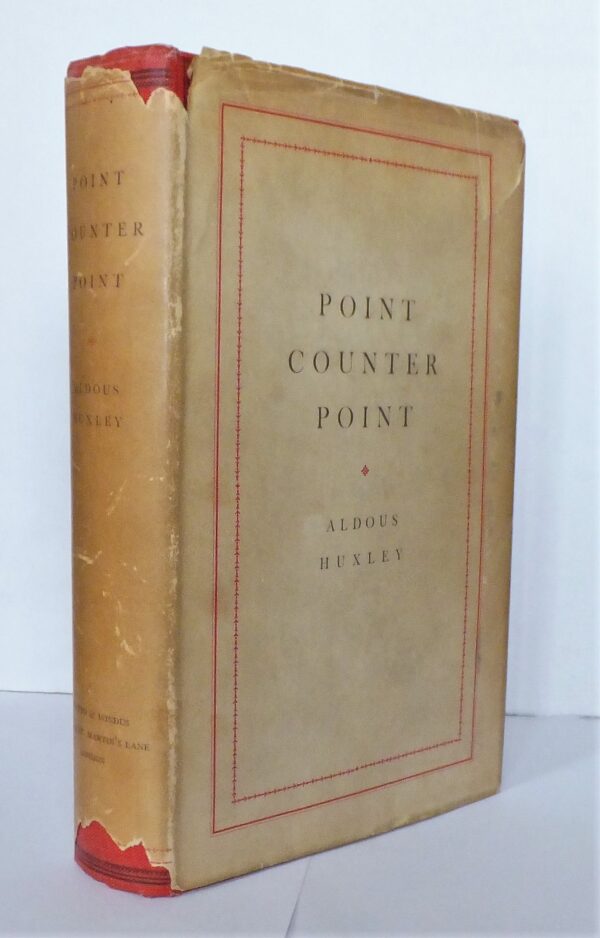
Point Counter Point
Aldous Huxley 1st printing in publisher's original cloth with perimeter ruling to board and spine and titles to spine in black - all still fresh, clean and bright with the slightest hint of bumping/rubbing to top spin end. The binding is sound, tight and square. Internally neat, scripted and dated [1928] ownership signature to centre of ffep; otherwise entirely clean and fresh. The unclipped dust jacket is good only having some limited loss at spine ends, tiny chips at fold ends, a short closed tear at top of rear panel [2cms] and a little soiling generally except at flaps [see relevant images].Jacket now presented in a removable, transparent cover. A nice copy in jacket.- $170
- $170
![I Love You Ronnie: The Letters of Ronald Reagan to Nancy Reagan [signed]](https://rarebookinsider.com/wp-content/uploads/2021/08/30989885094-600x1030.jpg)
I Love You Ronnie: The Letters of Ronald Reagan to Nancy Reagan [signed]
Nancy Reagan 2nd printing in publisher's original light blue paper covered boards with mid blue cloth spine and titles to spine in silver - all still fresh, clean and bright with very minor bumping to spine ends and corners. The binding is sound, tight and square. Internally Nancy Reagan's signature to dedicated The Ronald Reagan Presidential Library and Museum bookplate - pages crisp, fresh and clean.The unclipped dust jacket is crisp and vibrant with a hint of bumping/creasing occasionally at edges. A very nice copy.- $170
- $170
![A House for Mr Biswas [signed]](https://rarebookinsider.com/wp-content/uploads/2021/08/30989882111-600x913.jpg)
A House for Mr Biswas [signed]
V.S. Naipaul 5th printing signed for The New Fiction Society - in publisher's original black cloth with titles to spine in gilt - still very good with very minor bumping/creasing at spine ends. The binding is sound, tight and square. Internally clean and fresh with dedicated new fiction society's stamp and author's signature directly to ffep. The unclipped dust jacket remains complete and crisp with just the slightest hint of darkening at edges. A very nice copy.- $276
- $276
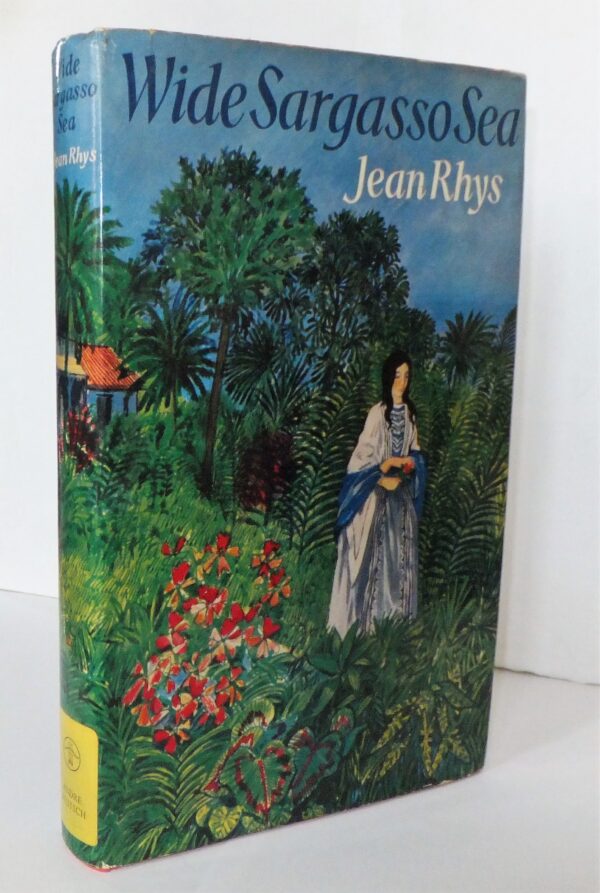
Wide Sargasso Sea
Jean Rhys 2nd impression [same year as 1st] in publisher's original matt-red cloth with titles in gilt to spine - all still fresh, clean and bright. The binding is sound, tight and square. Internally neat scripted gift inscription to top, right corner of ffep; ffeps a little off-set with some very light foxing/spotting. Otherwise internally clean. The price-clipped dust jacket remains crisp and vibrant with just a hint of edge wear occasionally and a couple of tiny nicks. A nice copy- $105
- $105
![The Unconsoled [signed]](https://rarebookinsider.com/wp-content/uploads/2021/08/30986483726-600x1035.jpg)
The Unconsoled [signed]
Kazuo Ishiguro 1st printing with full number series 1-10 on copyright page. In publisher's original black cloth with titles in ivory to spine - all still fresh, clean and bright with the slightest hint of bumping to top spine end. The binding is sound, tight and square with a hint of spotting to top edge of page block. Internally clean and fresh with author's signature directly to title page with no further inscription. The unclipped dust jacket remains crisp and vibrant with maybe a little creasing to top spine end.There is also a 'signed copy' publicity band -supporting the provenance of the signature- with a little creasing at bottom edge of spine section. A very nice copy.- $105
- $105
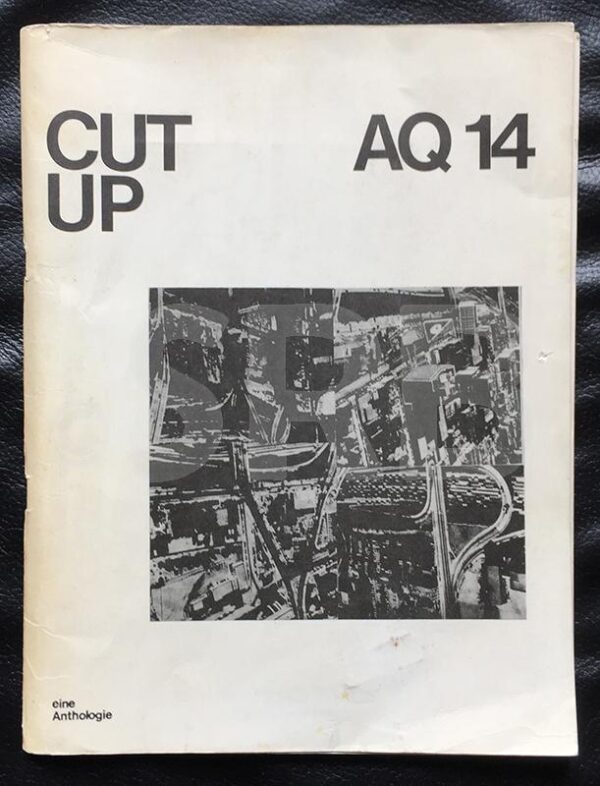
Cut Up, eine Anthologie. AQ 14.
BREGER (U.), PAULL (S.), STEGENTRITT (E.). 25 x 19 cm, 68 p., ill. Broché, couv. ill. Edition originale de cette anthologie de cut-ups de Bain, Beach, Breger, Burroughs, Pélieu, Fauser, Gibbs, Guthrie, Hanak, Kollmann, Kolonah, Mayor, Norse, Nuttall, Plymell, Stalter, Weissner. tetxes en anglais et allemand.- $145
- $145
